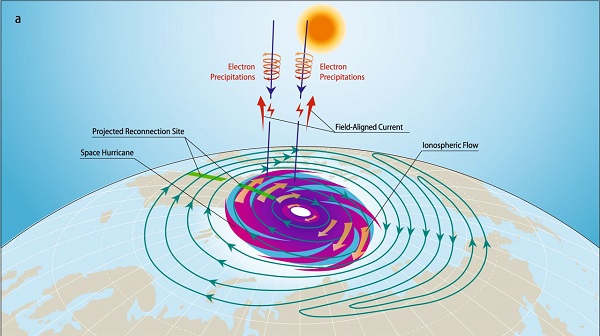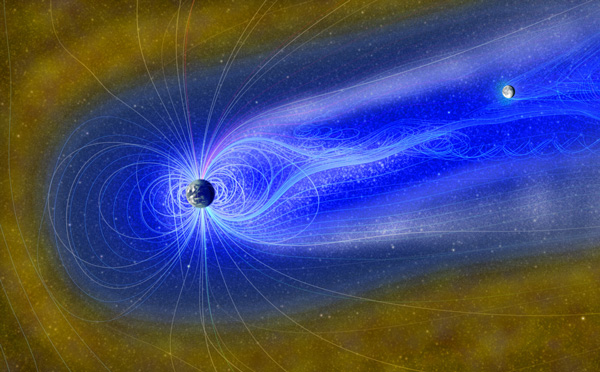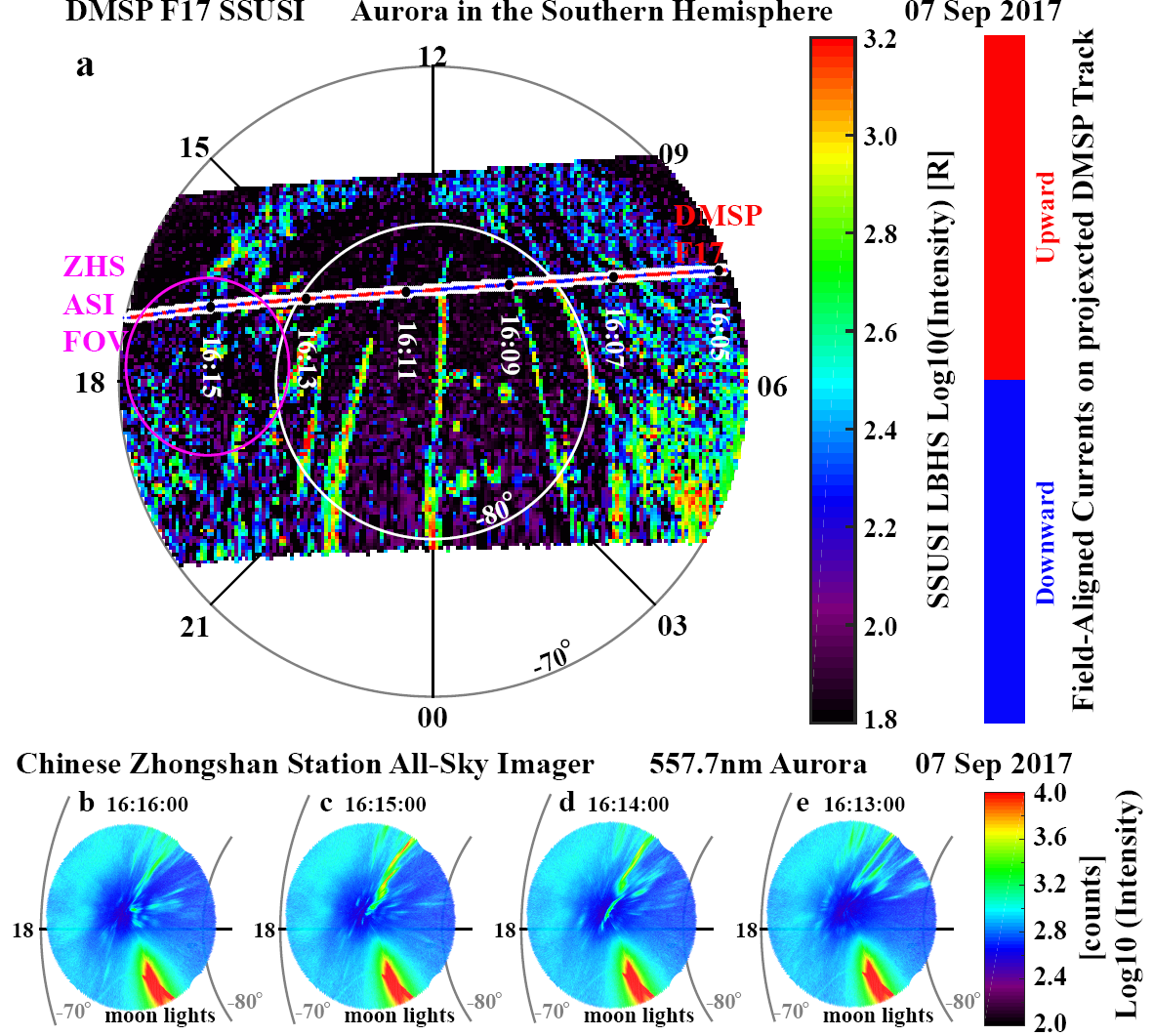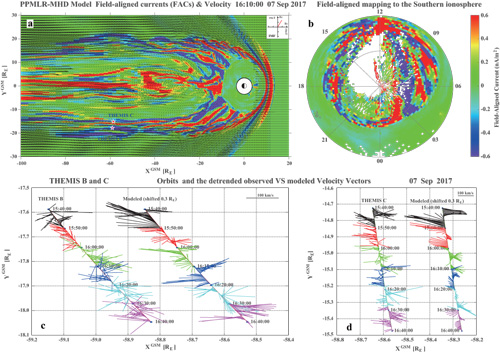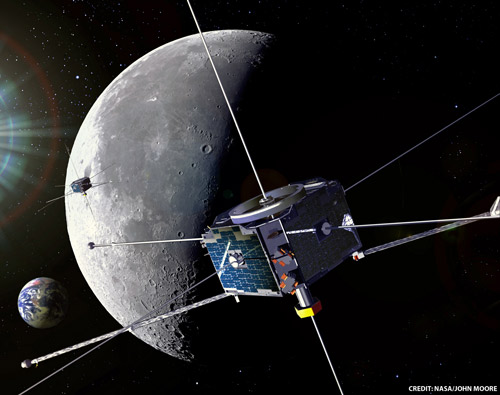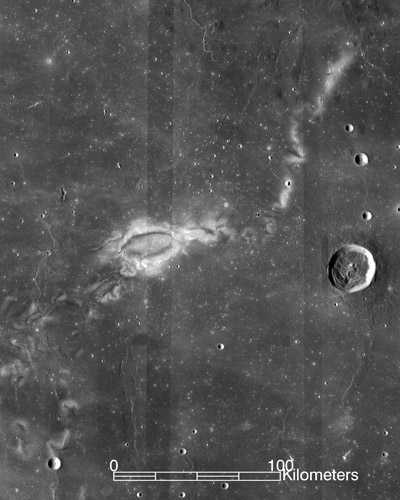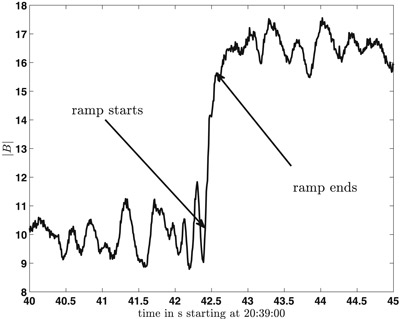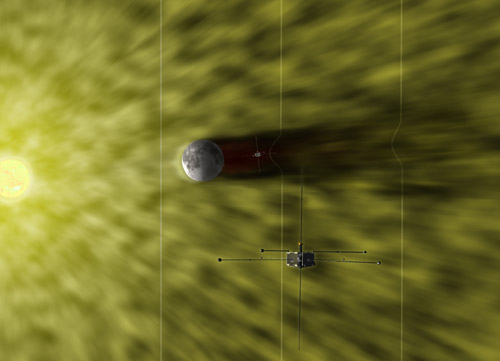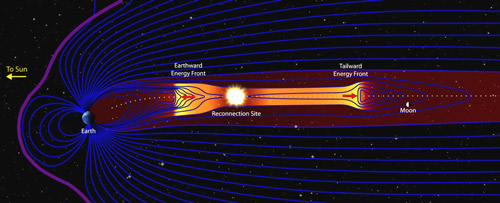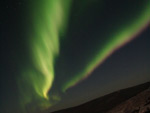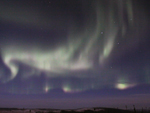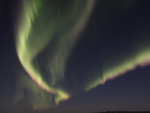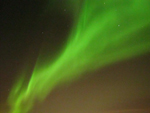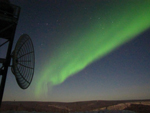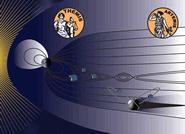ARTEMIS News
June 22, 2025:
Younas et al. Use ARTEMIS Observations to Link Solar Wind Conditions to Ground-Level GPS Disruptions During the May 2024 'Gannon Storm'
Continued from the front page:
Congratulations to the authors — Waqar Younas, Yusuke Nishimura, Wenbin Liao, Jeffrey L. Semeter, Samuel Mrak, Yu J. Morton, and Kenneth M. Groves — on their impactful new research published in Journal of Geophysical Research: Space Physics. Their paper, Spatio-temporal evolution of mid-latitude GPS scintillation and position errors during the May 2024 solar storm, offers a critical look into how extreme space weather events disrupt modern infrastructure.
In May 2024, a sequence of powerful solar eruptions culminated in what would later be named the “Gannon” solar storm — the most intense to hit Earth in two decades. Named in honor of the late space weather scientist Jennifer Gannon, the storm dazzled skywatchers with auroras visible as far south as Mexico and Spain, but it also caused serious disruption to GPS systems across North America. A new study has now revealed just how extensive and long-lasting those effects were.
The research team from Boston University leveraged a network of nearly 100 fixed high-precision GPS receivers — part of a seismic monitoring system — to track disturbances in the ionosphere, the electrically charged upper layer of Earth's atmosphere. This network, while designed for geophysics, proved uniquely well-suited to detect fluctuations in GPS signals caused by turbulent space weather.
Their analysis showed that the solar storm created a massive “wall” of dense ionospheric plasma stretching across the U.S. This plasma wall interfered with GPS signal transmission, leading to positioning errors of up to 230 feet (70 meters) in the central U.S. and up to 65 feet (20 meters) in southwestern regions. While the most intense disruption lasted about six hours on May 10, irregularities continued for nearly two days, particularly during extended auroral activity.
The timing couldn’t have been worse for American farmers. At the height of the spring planting season, precision-guided tractors suddenly veered off-course or became inoperable, resulting in planting delays and an estimated $500 million in crop losses. With nearly 70% of U.S. farmland relying on GPS-guided systems, the storm exposed a major vulnerability in current agricultural practices.
Aviation systems also felt the impact. While minor GPS errors are typically manageable, the Gannon storm pushed signal deviations far beyond the threshold for safe aircraft landings, according to co-author Yusuke Nishimura. These findings underscore the high stakes of maintaining GPS accuracy, especially for industries where positioning precision is critical.
Though the Gannon storm was the strongest in years, scientists warn it was still far less intense than a potential Carrington-class event — a once-in-a-century solar storm like the one that occurred in 1859. A storm of that magnitude today could render GPS signals completely unreliable across entire continents.
Looking ahead, lead author Waqar Younas emphasizes the need for better forecasting of ionospheric disturbances. Combining real-time monitoring systems with AI-powered prediction models could allow for dynamic GPS correction during solar storms, helping to mitigate the risks for technology-dependent sectors.
This study is a powerful reminder that as we grow more reliant on satellite-based infrastructure, our vulnerability to solar weather grows with it.
Tereza Pultarova. (2025), May 2024 solar storm cost $500 million in damages to farmers, new study reveals, Space.com, Published June 22, 2025.
Citation:
Younas, W., Nishimura, Y., Liao, W., Semeter, J. L., Mrak, S., Morton, Y. J., and Groves, K. M. (2025). Spatio-temporal evolution of mid-latitude GPS scintillation and position errors during the May 2024 solar storm. Journal of Geophysical Research: Space Physics, 130, e2025JA033839. https://doi.org/10.1029/2025JA033839
January 13, 2025:
ARTEMIS observations of diffusive shock acceleration, published in Nature Communications
Congratulations to S. Raptis et al. for their recent publication and highlight in Nature Communications, on the process of reinforced shock acceleration.
Scientists have come a step closer to understanding how collisionless shock waves -- found throughout the universe -- are able to accelerate particles to extreme speeds. These shock waves are one of nature's most powerful particle accelerators and have long intrigued scientists for the role they play in producing cosmic rays -- high-energy particles that travel across vast distances in space.
The research, published today in Nature Communications, combines satellite observations from NASA's MMS (Magnetospheric Multiscale) and THEMIS/ARTEMIS missions with recent theoretical advancements, offering a comprehensive new model to explain the acceleration of electrons in collisionless shock environments. The paper, 'Revealing an Unexpectedly Low Electron Injection Threshold via Reinforced Shock Acceleration', was written by a team of international academics, led by Dr Savvas Raptis of The Johns Hopkins University Applied Physics Laboratory, in the USA, and in collaboration with Northumbria University's Dr Ahmad Lalti.
This research addresses a long-standing puzzle in astrophysics -- how electrons reach extremely high, or relativistic, energy levels. For decades, scientists have been trying to answer a crucial question in space physics: What processes allow electrons to be accelerated to relativistic speeds? The main mechanism to explain acceleration of electrons to relativistic energies is called Fermi acceleration or Diffusive Shock Acceleration (DSA). However, this mechanism requires electrons to be initially energized to a specific threshold energy before getting efficiently accelerated by DSA. Trying to address how electrons achieve this initial energy is known as 'the injection problem'. This new study provides key insights into the electron injection problem, showing that electrons can be accelerated to high energies through the interaction of various processes across multiple scales.
Using real-time data from the MMS mission, which measures the interaction of Earth's magnetosphere with the solar wind, and the THEMIS/ARTEMIS mission, which studies the upstream plasma environment near the Moon, the research team observed a large scale, time dependent (i.e. transient) phenomenon, upstream of Earth's bow shock, on December 17, 2017. During this event, electrons in Earth's foreshock region -- an area where the solar wind is predisturbed by its interaction with the bow shock -- reached unprecedented energy levels, surpassing 500 keV. This is a striking result given that electrons observed in the foreshock region are typically found at energies ~1 keV
This research suggests that these high-energy electrons were generated by the complex interplay of multiple acceleration mechanisms, including the interaction of electrons with various plasma waves, transient structures in the foreshock, and Earth's bow shock. All of those mechanisms act together to accelerate electrons from low energies ~ 1keV up to relativistic energies reaching the observed 500 keV, resulting in a particularly efficient electron acceleration process. By refining the shock acceleration model, this study provides new insight into the workings of space plasmas and the fundamental processes that govern energy transfer in the universe.
Sources:Anon. (2025), New study unveils breakthrough in understanding cosmic particle accelerators, Northumbria Univ, Published January 13, 2025.
Raptis, S. (2025), How do relativistic electrons form at shocks?, Springer Behind the Paper, Published Jan. 13, 2025.
Plain, C. (2025), Near-Light Speeds: How Astrophysical Shock Waves Act as Cosmic Particle Accelerators, The Debrief, Published January 15, 2025.
Malewar, A. (2025), How collisionless shock waves can accelerate particles to extreme speeds?, TechExplorist, Published January 13, 2025.
Citation:
Raptis, S., Lalti, A., Lindberg, M. et al. Revealing an unexpectedly low electron injection threshold via reinforced shock acceleration. Nat Commun, 2025 DOI: 10.1038/s41467-024-55641-9
July 11, 2022:
NASA Gateway HERMES will complement ARTEMIS:
Much of the initial science taking place on the Gateway space station that will orbit the Moon will focus on radiation from the Sun and deep space. A trio of radiation instruments planned for Gateway, an important element of NASA’s Artemis missions, will help scientists better understand how to plan for the unpredictable space weather resulting from the Sun and galactic cosmic rays from deep space that astronauts, spacecraft and hardware will encounter on travels to the Moon and Mars.
Space weather—a primary risk to human health and mission success during travels farther away from Earth and the protection of the magnetosphere – is a catchall term to describe the fluctuating conditions in space driven by the Sun. It includes a continuous stream of particles and magnetic fields, known as solar wind, blasts of billion-ton gas clouds known as coronal mass ejections, and flashes of ultra-bright light from solar flares.
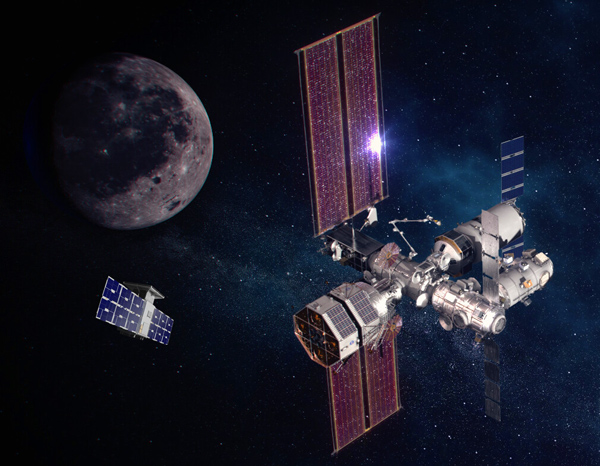 |
| A view of the full Gateway configuration at right, with CAPSTONE CubeSat at left. (Credit: NASA/Alberto Bertolin) |
Gateway will operate in a near-rectilinear halo orbit around the Moon, far from Earth’s protective atmosphere and magnetic fields that largely shield humans, including astronauts living on the International Space Station in low-Earth orbit, from space weather and radiation. Radiation impacts on the human body will be much greater on missions to the Moon or Mars, where exposure to high-energy, charged particles can cause adverse health effects including increased risk of cancers, changes in motor functions and behavior, and degeneration of tissue. Additional risks include potential damage to astronauts’ vehicles and equipment that they rely on to live and travel safely through space.
The three instruments on Gateway that will advance scientists’ knowledge of space weather to help them understand risks posed by radiation are the Heliophysics Environmental and Radiation Measurement Experiment Suite (HERMES), the European Radiation Sensors Array (ERSA), and the Internal Dosimeter Array (IDA).
Heliophysics Environmental and Radiation Measurement Experiment SuiteLed by NASA’s Goddard Space Flight Center in Greenbelt, Maryland, HERMES will be attached to the outside of Gateway and glimpse what’s happening deep in the Earth’s magnetotail. This will allow NASA to compare its observations to two of the five Time History of Events and Macroscale Interactions (THEMIS) spacecraft, a pair of Moon-orbiters that carry instruments similar to HERMES. The ability to collect data simultaneously from the three instrument suites in different locations is a rare opportunity to reconstruct solar wind behavior as it changes over time.
The science payload consists of four instruments mounted together on a platform: a magnetometer to measure the magnetic fields around Gateway; the Miniaturized Electron pRoton Telescope (MERiT) to measure ions and electrons; the Electron Electrostatic Analyzer (EEA) to measure the lower-energy electrons that make up most of the solar wind; and the Solar Probe Analyzer for Ions (SPAN-I) to measure protons and ions such as oxygen. The magnetometer, MERiT and EEA are provided by Goddard and SPAN-I is provided by the University of California, Berkeley.
Sources:Zaid, C. (2022), A New Era of Science on the Lunar Gateway, NASA News, July 11, 2022.
May 26, 2022:
NASA-funded CAPSTONE moon mission seeks to go where no CubeSat has gone before:
A cubesat mission has a big objective to verify a keystone of NASA's future lunar operations. CAPSTONE, short for "Cislunar Autonomous Positioning System Technology Operations and Navigation Experiment," will occupy an orbit around the moon that has never been used before, to test out the Gateway space station's path to support future Artemis astronauts on the lunar surface. The microwave-oven-sized spacecraft's mission is to settle into a near rectilinear halo orbit (NRHO) around the moon.
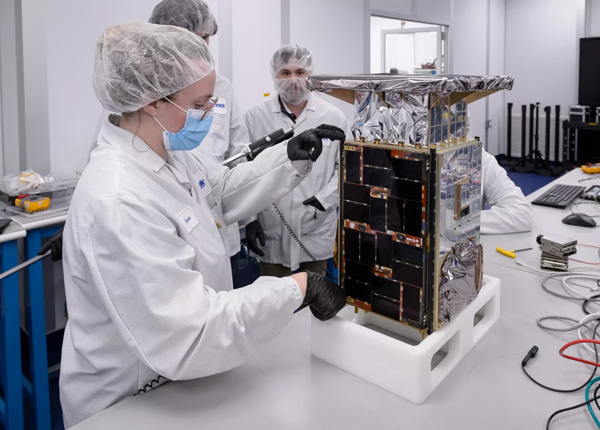 |
| CAPSTONE technicians inspect the spacecraft at Tyvak Nano-Satellite Systems, Inc. in California. (Image credit: NASA/Dominic Hart) |
CAPSTONE will verify the stability of the orbit, which can be affected by mass concentrations (mascons) near the moon's surface and other factors. NASA is keen to get such information before launching the the high-profile Gateway space station to a lunar NRHO later in the 2020s.
CAPSTONE's NRHO will take the cubesat within 1,000 miles (1,600 kilometers) of the lunar surface near the south pole at its lowest point, and as high up as 43,500 miles (70,000 km).
The low approach to the moon will eventually allow access for astronauts to land on the surface and to return to Gateway, provided that the orbit is verified as desired. An NHRO also allows for efficient fuel usage, which is useful for a tiny cubesat, along with eclipse-free operations allowing the solar-powered Gateway to receive continual sunlight, Bradley Cheetham, Advanced Space CEO and principal investigator of CAPSTONE, said during the press conference.
The only other projects to attempt any three-body orbits around the moon include China's Chang'e 4 mission to the moon's far side and a previous robotic NASA mission called (somewhat confusingly, as Cheetham noted) ARTEMIS.
The older ARTEMIS stands for "Acceleration, Reconnection, Turbulence and Electrodynamics of the Moon's Interaction with the Sun." The mission was repurposed from two of five spacecraft used for a NASA heliophysics constellation of satellites called THEMIS, which operated between 2007 and 2010.
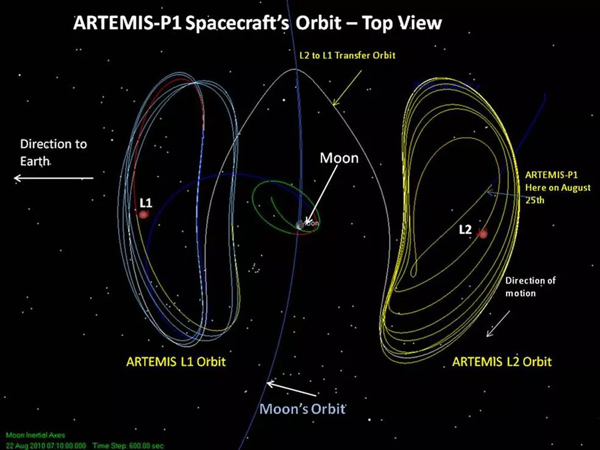 |
| Illustration of the orbit undertaken by a previous spacecraft, ARTEMIS-P1, at the moon in 2010. (Image credit: NASA/Goddard) |
Two spacecraft, renamed ARTEMIS-P1 and ARTEMIS-P2, tested out station-keeping(opens in new tab) around Lagrange points (gravitationally stable points between bodies) near the moon. Cheetham was working at NASA's Goddard Space Flight Center in Maryland during that period and said that the mission inspired him to enter graduate school for a Ph.D.
"That mission started the passion that I had for these unique orbits, that really led to the growth of these ideas and, ultimately, the CAPSTONE mission," Cheetham said.
CAPSTONE mission team members aim to verify predicted fuel usage in the NRHO, as well as how well ground navigation does in terms of tracking the cubesat, he noted.
Sources:Howell, E. (2022) NASA-funded CAPSTONE moon mission seeks to go where no cubesat has gone before, Space.com, May 26, 2022.
March 1, 2021:
Discovery of space hurricane in Earth's ionosphere :
Congrats to Zhang et al. for their discovery of a polar ionosphere "space hurricane," published in Nature Communications and covered widely in the news. ARTEMIS and DMSP data were used to profile this event, which occured during quiet geomagnetic conditions.
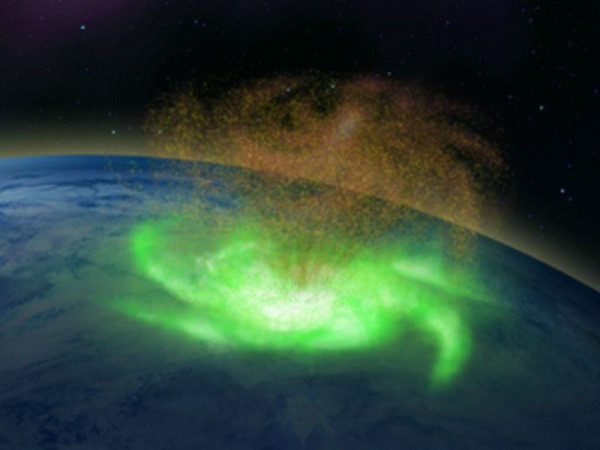 |
| An illustration based on the satellite observation data from the first confirmed instance of a space hurricane. Credit: Q.-H. Zhang, Shandong University |
An international team of researchers led by Prof. Qing-He Zhang from Shandong University, China, have detected a space hurricane in the Earth’s polar ionosphere and magnetosphere by combining satellite observations and high-resolution 3D global MHD simulations. Using data from ARTEMIS and four DMSP spacecraft, the team found a huge and long-lasting (~8 hours) cyclone-like auroral spot (diameter over 1000 km) with multiple arms and a trend of anti-clockwise rotation around the north magnetic pole.
This cyclone-like auroral spot is also associated with 1) a spot-like strong upward field-aligned current (FAC) with a hole developing sometimes in the center, 2) zero horizontal flow near its center (the hurricane eye) as well as strong flow shears around the edges, 3) ion upflows, 4) enhanced electron temperature ~1000 K, 5) a negative-to-positive bipolar magnetic structure implying a circular magnetic field perturbation, 6) electron inverted-V acceleration to above 10 keV, and 7) large and rapid deposition of energy and flux into the polar ionosphere (much stronger precipitating electron energy flux than during typical quiet and substorm conditions, and comparable to that during super storms). These features are very similar to a hurricane in the low atmosphere, thus, the team analogically named it a "space hurricane."
This study suggests that there exist local intense geomagnetic disturbances and energy depositions which can update our understanding of the solar wind-magnetosphere-ionosphere coupling process under extremely quiet geomagnetic conditions. In addition, the space hurricane may influence important space weather effects like increased satellite drag, disturbances in High Frequency (HF) radio communications, and increased errors in over-the-horizon radar location, satellite navigation and communication systems.
Sources:Wheeling, K. (2021), A space hurricane spotted above the polar cap, Eos, 102, https://doi.org/10.1029/2021EO156976. Published on 09 April 2021.
Rice, D. (2021) A 'space hurricane' hovered above the North Pole for about 8 hours, study says, USA Today, March 3, 2021.
Garcia-Navarro, L. (2021) Scientists Observe First Ever 'Space Hurricane', NPR Weekend Edition, March 7, 2021.
Citation:
Zhang, Q.-H., Zhang, Y.-L., Wang, C., Oksavik, K., Lyons, L. R., Lockwood, M., Yang, H.-G., Tang, B.-B., Moen, J. I., Xing, Z.-Y., Ma, Y.-Z., Wang, X.-Y., Ning, Y.-F., Xia, L.-D., (2021), A space hurricane over the Earth's polar ionosphere, Nat. Comm., 12, 1207. https://doi.org/10.1038/s41467-021-21459-y
January 28, 2021:
First evidence that water can be created on the lunar surface by Earth's magnetosphere:
Congrats to Wang et al. for their recent report of lunar surface water formation by magnetosphere ions, published in ApJ Letters. ARTEMIS profiled the ions in the magnetosphere and solar wind, while spectra from the M3 instrument on Chandrayaan-1 measured OH-/H2O changes on the surface.
Before the Apollo era, the moon was thought to be dry as a desert due to the extreme temperatures and harshness of the space environment. Many studies have since discovered lunar water: ice in shadowed polar craters, water bound in volcanic rocks, and unexpected rusty iron deposits in the lunar soil. Despite these findings, there is still no true confirmation of the extent or origin of lunar surface water.
The prevailing theory is that positively charged hydrogen ions propelled by the solar wind bombard the lunar surface and spontaneously react to make water (as hydroxyl (OH-) and molecular (H2O)). However, a new multinational study published in Astrophysical Journal Letters proposes that solar wind may not be the only source of water-forming ions. The researchers show that particles from Earth can seed the moon with water, as well, implying that other planets could also contribute water to their satellites.
Water is far more prevalent in space than astronomers first thought, from the surface of Mars to Jupiter's moons and Saturn's rings, comets, asteroids and Pluto; it has even been detected in clouds far beyond our solar system. It was previously assumed that water was incorporated into these objects during the formation of the solar system, but there is growing evidence that water in space is far more dynamic. Though the solar wind is a likely source for lunar surface water, computer models predict that up to half of it should evaporate and disappear at high-latitude regions during the approximately three days of the full moon when it passes within Earth's magnetosphere.
Surprisingly, the latest analysis of surface hydroxyl/water surface maps by the Chandrayaan-1 satellite's Moon Mineralogy Mapper (M3) showed that lunar surface water does not disappear during this magnetosphere shielding period. Earth's magnetic field was thought to block the solar wind from reaching the moon so that water could not be regenerated faster than it was lost, but the researchers found this was not the case.
By comparing a time series of water surface maps before, during and after the magnetosphere transit, the researchers argue that lunar water could be replenished by flows of magnetospheric ions, also known as "Earth wind." The presence of these Earth-derived ions near the moon was confirmed by the Kaguya satellite, while THEMIS-ARTEMIS satellite observations were used to profile the distinctive features of ions in the solar wind versus those within the magnetosphere Earth wind.
Previous Kaguya satellite observations during the full moon detected high concentrations of oxygen isotopes that leaked out of Earth's ozone layer and embedded in lunar soil, along with an abundance of hydrogen ions in our planet's vast extended atmosphere, known as the exosphere. These combined flows of magnetosphere particles are fundamentally different from those in the solar wind. Thus, the latest detection of surface water in this study refutes the shielding hypothesis and instead suggest that the magnetosphere itself creates a "water bridge" that can replenish the moon.
The study employed a multidisciplinary team of experts from cosmochemistry, space physics and planetary geology to contextualize the data. Prior interpretations of surface water did not consider the effects of Earth ions and did not examine how surface water changed over time. The only surface maps and particle data available during a full moon in the magnetosphere were in winter and summer 2009, and it took the past several years to analyze and interpret the results. The analysis was especially difficult due to the scarce observations, which were required to compare the same lunar surface conditions over time and to control for temperature and surface composition.
In light of these findings, future studies of the solar wind and planetary winds can reveal more about the evolution of water in our solar system and the potential effects of solar and magnetosphere activity on other moons and planetary bodies. Expanding this research will require new satellites equipped with comprehensive hydroxyl/water mapping spectrometers, and particle sensors in orbit and on the lunar surface to fully confirm this mechanism. These tools can help to predict the best regions for future exploration, mining and eventual settlement on the moon. Practically, this research can influence the design of upcoming space missions to better safeguard humans and satellites from particle radiation hazards, and also improve computer models and laboratory experiments of water formation in space.
Sources:Masongsong, E. (2021) First evidence that water can be created on the lunar surface by Earth's magnetosphere, Phys.org, Jan 28, 2021.
Gough, E. (2021) The Earth's Magnetosphere Might be Creating Water on the Moon, Universe Today, Feb 3, 2021.
Phillips, T. (2021) A New Form of Space Weather: Earth Wind, Spaceweather.com Feb 12, 2021.
Citation:
Wang, H. Z. J. Zhang, Q. Q. Shi, Y. Saito, A. W. Degeling, I. J. Rae, Q.G. Zong, Y. Wei, J. Liu, R. L. Guo, Z. H. Yao, A. M. Tian, X. H. Fu, J. Z. Liu, Z. C. Ling, S. Y. Fu, W. J. Sun, S. C. Bai, J. Chen, S. T. Yao, H. Zhang, W. L. Liu, L. D. Xia, Y. Y. Feng, Z. Y. Pu (2021), Earth wind as a possible exogenous source of lunar surface hydration, Astrophysical Journal Letters, 907, L32. https://doi.org/10.3847/2041-8213/abd559
July 7, 2020:
ARTEMIS, multi-instrument observations and MHD simulations explain formation of theta aurora:
Professor Qing-He Zhang of Shandong University and his team combined comprehensive observations in the ionosphere and magnetotail as well as a 3-D magnetosphere modeling, to explain the formation mechanism of multiple transpolar auroral arcs (TPA).
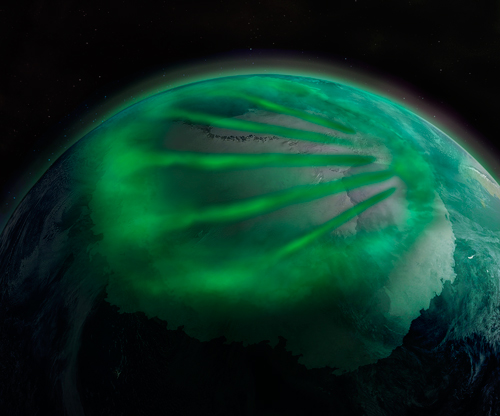 |
| Rendering of the Earth's south pole, showing multiple trans polar arcs spanning across the auroral oval. Credit: Q.-H. Zhang, Shandong University. |
Colorful and dynamic auroras have attracted humans' attention since the dawn of time. However, a mystery remained in understanding a distinct class of aurora called transpolar auroral arc, that stretches almost entirely across the polar cap and connects the dayside and nightside auroral oval. Also known as the “theta” aurora, it appears in the extremely high latitude ionosphere of the Earth when the interplanetary magnetic field (IMF) is northward, which occurs nearly half of the time. The formation and evolution of TPA offers clues about processes transferring energy and momentum from the solar wind to the magnetosphere and ionosphere during northward IMF. The associated auroral particle precipitation can cause ionospheric scintillations, which could disrupte communications and navigation in polar regions.
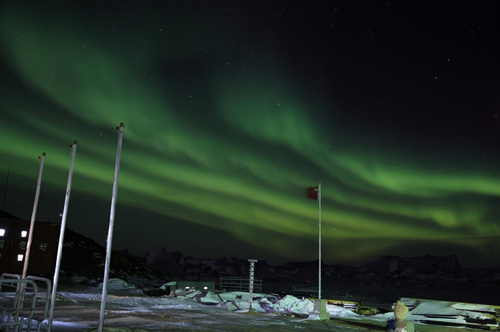 |
| Multiple auroral arcs photo taken at the Chinese Antarctic Zhongshan station. Credit: Q.-H. Zhang, Shandong Univ. |
Previous theories are unable to explain why multiple TPAs often occur, and the formation mechanism of multiple TPAs remains poorly understood and controversial. By using comprehensive observations from the ionospheric DMSP satellite, magnetospheric ARTEMIS satellites, an all sky imager at the Chinese Zhongshan station, and a high resolution 3D global MHD simulation (PPMLR-HMD), Professor Zhang's group was able to resolve this scientific problem.
They report in the Proceedings of the National Academy of Sciences a new mechanism identified from multi-instrument observations of unusually bright, multiple TPAs, and simulations from the PPMLR-HMD model. On 7 September 2017, long-lasting, relatively stable northward IMF conditions (IMF Bz > 0 for more than 8 hours) occurred with comparable dawn-dusk components (IMF By) and roughly stable solar wind and quiet geomagnetic conditions. At least six bright TPAs are shown in the polar cap, where several of the TPAs were brighter than the main auroral oval with brighter spots within them. The observations and simulations show an excellent agreement and reveal that these multiple TPAs are generated by precipitating energetic magnetospheric electrons within field-aligned current (FAC) sheets. These FAC sheets are generated by multiple flow shear sheets in both the magnetospheric boundary produced by the Kelvin-Helmholtz instability between super-sonic solar wind flow and magnetosphere plasma, and the plasma sheet. These flow shears directly lead to multiple FAC sheets and field-aligned acceleration of electrons which create multiple cusp-aligned auroral arcs both in the polar cap and auroral oval. This is a general mechanism for the formation of auroral arcs. The reviewers said: "...the paper resolves some apparent difficulties that have faced the interpretation of TPAs. I would therefore consider this paper to offer more than an incremental step in our understanding of TPAs."
This work was supported by the Chinese Meridian Project, the National Natural Science Foundation, the Specialized Research Fund for State Key Laboratories of China and National Key Laboratory of Electromagnetic Environment and the International Space Science Institute in Beijing.
Sources:Zanyang, X., (2020), New Progress in the Research of Formation Mechanism of Multiple Transpolar Auroral Arcs, Shandong, July 7, 2020.
Citation:
Zhang, Q.-H., Zhang, Y.-L., Wang, C., Lockwood, M., Yang, H.-G., Tang, B.-B., Xing, Z.-Y., Oksavik, K., Lyons, L.R. Ma, Y.-Z., Zong, Q.-Z., Moen, J.I., Xia, L.-D. (2020), Multiple transpolar auroral arcs reveal insight about coupling processes in the Earth’s magnetotail, PNAS, 202000614; DOI: 10.1073/pnas.2000614117
June 30, 2020:
NASA Spacecraft Helps Identify Solar Radiation Patterns That Expose the Moon (continued from home page):
Which way the wind blows in space has new importance for astronaut safety at the Moon. Using data from several NASA missions, scientists discovered that wind created by high-speed particles from the Sun can cause the tail of Earth's protective magnetic bubble to flap like a windsock in a strong breeze. This movement can pull the tail so far out of line that it exposes the Moon to potentially damaging charged particles at times it was previously thought to be protected. The finding, which reveals a new challenge of predicting when solar activity exposes the Moon, will help scientists and engineers prepare for future lunar missions.
Our Sun provides life-giving light, but it also spews out high-speed particles – the solar wind, in which some very high energy particle bursts can be damaging to satellites and humans in space. While Earth is safe inside its magnetic bubble – the magnetosphere – the Moon continually passes into and out of the stretched-out tail of this protective bubble as it orbits the planet. During the 25% of the time the Moon spends behind Earth – in the full Moon phase – it is inside the magnetosphere and thought to be protected. But this new research, published in the Journal of Geophysical Research: Space Physics, shows that's not always the case.
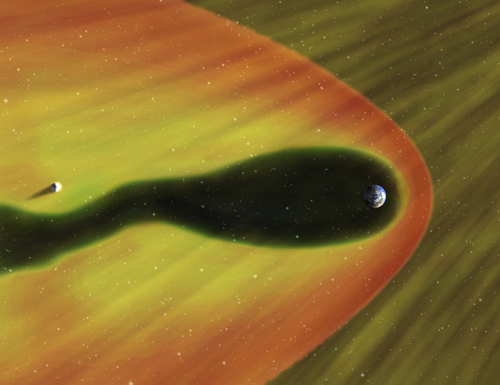 |
| Top down view, artist rendering showing how the flapping tail of Earth's magnetosphere (dark region) can leave the full moon exposed to solar wind radiation (yellow-orange). |
Scientists have previously shown that fairly far from Earth – at distances 800,000 miles from the planet – the solar wind can cause the tail of the magnetosphere to flap around. The new research found this also happens at just one-third that distance, where the Moon orbits. At times of high solar activity, the Sun can release extra bursts of material in the solar wind – shock waves that ripple across the solar system. When these shock waves reach Earth, they have enough pressure to change the shape of the magnetosphere, which is already stretched into a windsock-like shape due to the pressure from solar wind particles. If the wind after the shock wave is strong enough, it can cause enough movement to expose the Moon to the solar wind, even when it's directly behind Earth.
The new discovery used several of NASA's spacecraft to watch the effects of one high-speed shock wave that barreled towards Earth in 2012, traveling at 1.7 million miles per hour. The shock was first measured by the Advanced Composition Explorer, Cluster and Wind missions, which are all situated between Earth and the Sun. An hour later at the Moon, changes to the magnetic environment were seen by THEMIS-ARTEMIS – short for Time History of Events and Macroscale Interactions - Acceleration, Reconnection, Turbulence and Electrodynamics of the Moon's Interaction with the Sun. THEMIS-ARTEMIS, a separate mission from the agency's new Artemis program to explore the Moon, uses two satellites at the Moon to study the lunar space environment.
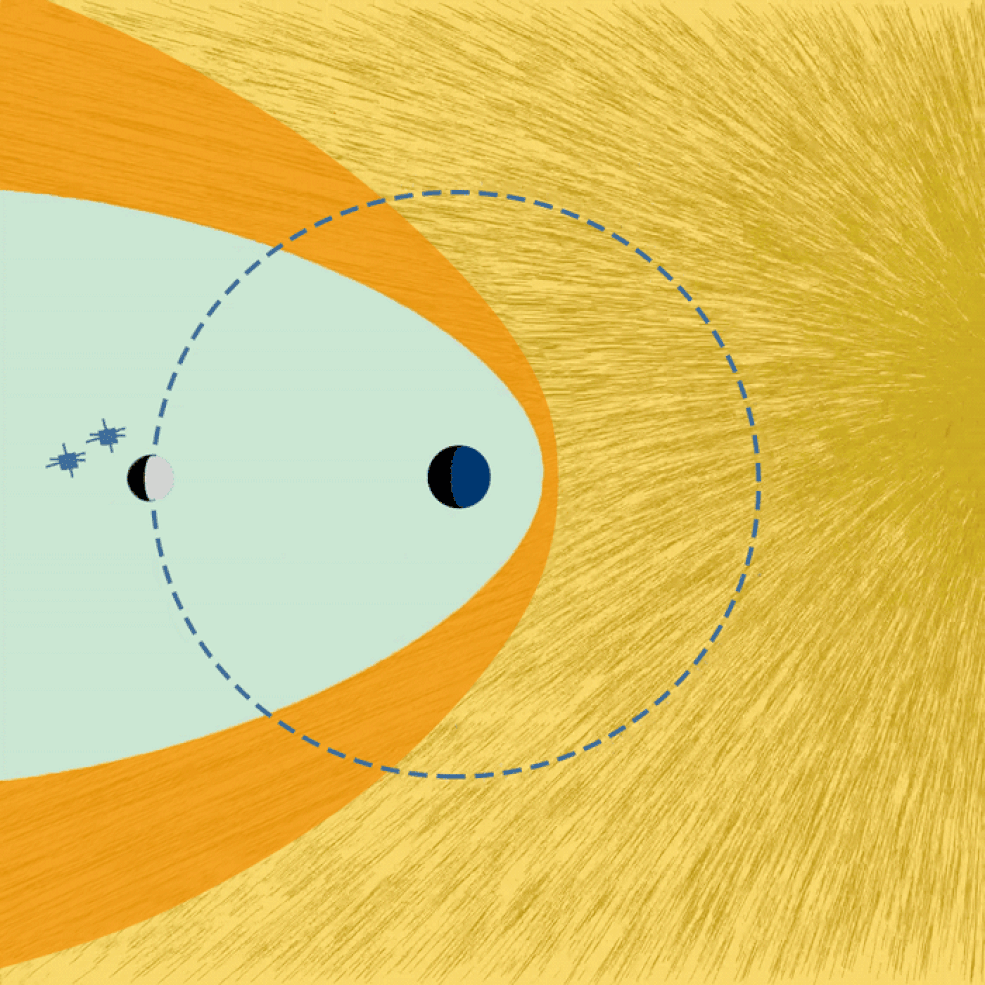 |
| When the solar wind blows, Earth's magnetosphere can flap in the breeze. When it's strong enough, it can expose the Moon to particle radiation. Credits: Genna Duberstein/ADNET/Q.Q. Shi/Shandong Univ. |
The data from the missions showed that the strong wind behind the shock wave pushed aside the magnetosphere's long trailing tail, causing it to wave back and forth like a windsock. The side-to-side movement was so large that it repeatedly exposed the Moon to the solar wind over a half hour period. This research also showed the lunar exposure could happen even without a shockwave – such as at times when the solar wind blows sideways – suggesting the exposure could occur even more commonly than previously thought.
 |
| This simulation shows how the shock wave event seen by NASA's spacecraft moved the tail of Earth's magnetosphere, exposing the Moon. Credits: Q.Q. Shi, Shandong Univ. |
As NASA's Artemis program prepares to send new science and technology experiments ahead of a human return, it is essential to understand the area's particle radiation environment, which can potentially damage electronics and humans during storm events. Data from THEMIS-ARTEMIS and other missions help scientists and engineers better understand the lunar environment and will help contextualize discoveries made on the Moon's surface and protect lunar assets.
Sources:Johnson-Groh, M., (2020), NASA Spacecraft Helps Identify Solar Radiation Patterns That Expose the Moon, NASA News, June 30, 2020.
Masongsong, E., (2020), The full moon may not be protected by Earth’s magnetic field after all, UCLA Newsroom, July 6, 2020.
UK's RAL Space Press Release
AGU Press Release (Chinese)
Space Research News Press Release (Hungarian)
Radio interview with co-author Gabor Fascko (Hungarian)
Citation:
Shang, W. S., Tang, B. B., Shi, Q. Q., Tian, A. M., Zhou, X.‐Y., Yao, Z. H., et al. (2020). Unusual location of the geotail magnetopause near lunar orbit: A case study. Journal of Geophysical Research: Space Physics, 125, e2019JA027401. https://doi.org/10.1029/2019JA027401
February 27, 2020:
2019 AGU Recipient of Outstanding Student Presentation Award:
Congrats to Ms. Stephanie Howard, a graduate student at the University of Iowa, who won an Outstanding Student Presentation Award for her Fall AGU presentation, entitled "Effects of the Lunar Plasma Environment on Reflected Ion Distributions and the Impact on Ultra Low Frequency Wave Generation." This work utilized ARTEMIS ESA and FGM data to show how solar wind ions reflected from small-scale lunar magnetic fields generate low frequency plasma waves around the Moon, and leveraged a unique joint analysis of the ion and magnetic field data to constrain the intrinsic characteristics of the observed waves. Ms. Howard's work with ARTEMIS data has also been reported in two articles in the Journal of Geophysical Research: Space Physics [Howard et al., 2017, 2020]. She will receive her Ph.D. this spring, and plans to start a postdoc position at NASA GSFC.
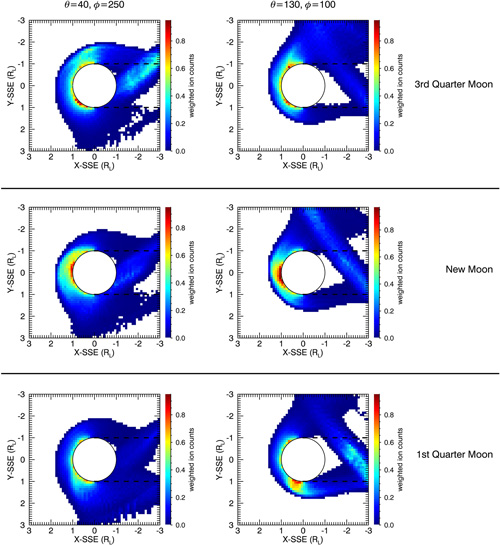 |
| Simulated spatial distributions of ions passing through the equatorial region under different IMF angles and lunar phases. Credit S.K. Howard, 2020. |
The OSPA program provides student presenters (both poster and oral) at AGU meetings the opportunity to receive valuable feedback about their research and presentation skills that will help them advance their careers. Presentations are reviewed and scored entirely by volunteer judges. OSPAs are awarded to promote, recognize, and reward undergraduate, Master's, and PhD students for quality research in Earth and space science and the ability to effectively communicate it. AGU Sections recruit judges to assess and score the presentations of students who have opted to participate in the program.
Source:AGU OSPA Award Winners
About the OSPA Competition
Howard, S. K., Halekas, J. S., Farrell, W. M., McFadden, J. P., & Glassmeier, K.-H. (2020). Solar Wind and Interplanetary Magnetic Field Influence on Ultra Low Frequency Waves and Reflected Ions Near the Moon. Journal of Geophysical Research: Space Physics, 125, e2019JA027209. https://doi.org/10.1029/2019JA027209
Howard, S. K., Halekas, J. S., Farrell, W., McFadden, J. P., & Glassmeier, K.-H. (2017). Identifying ultra low frequency waves in the lunar plasma environment using trajectory analysis and resonance conditions. Journal of Geophysical Research: Space Physics, 122. https://doi.org/10.1002/2017JA024018
October 7, 2019:
ARTEMIS and Artemis lunar missions explained by NASA News:
ARTEMIS will play a critical role for the upcoming manned Artemis missions, surveying the lunar radiation environment as a solar wind and space weather monitor.
Artemis, meet ARTEMIS: Pursuing Sun Science at the Moon
By 2024, NASA will land astronauts, including the first woman and next man, on the Moon as part of the Artemis lunar exploration program. This won't be the first time NASA takes the name Artemis to the Moon though. Two robotic spacecraft orbiting the Moon today were initially known as ARTEMIS — short for Acceleration, Reconnection, Turbulence and Electrodynamics of the Moon's Interaction with the Sun. Since 2011, these spacecraft have been sending scientists valuable information about the lunar environment, and laying groundwork critical to returning humans to the Moon.
The mission, now renamed THEMIS-ARTEMIS, uses spacecraft that were originally apart of the mission known as Time History of Events and Macroscale Interactions during Substorms, or THEMIS, for short, which launched five spacecraft in 2007 to discover the physical processes that occurred during the events that cause the auroras.
“THEMIS-ARTEMIS has been a pathfinder for technologies that will be important for NASA's new Artemis program,” said Jasper Halekas, THEMIS-ARTEMIS scientist and researcher at the University of Iowa in Iowa City. “Some of the work we've done in terms of navigation and operations will be used by future missions.”
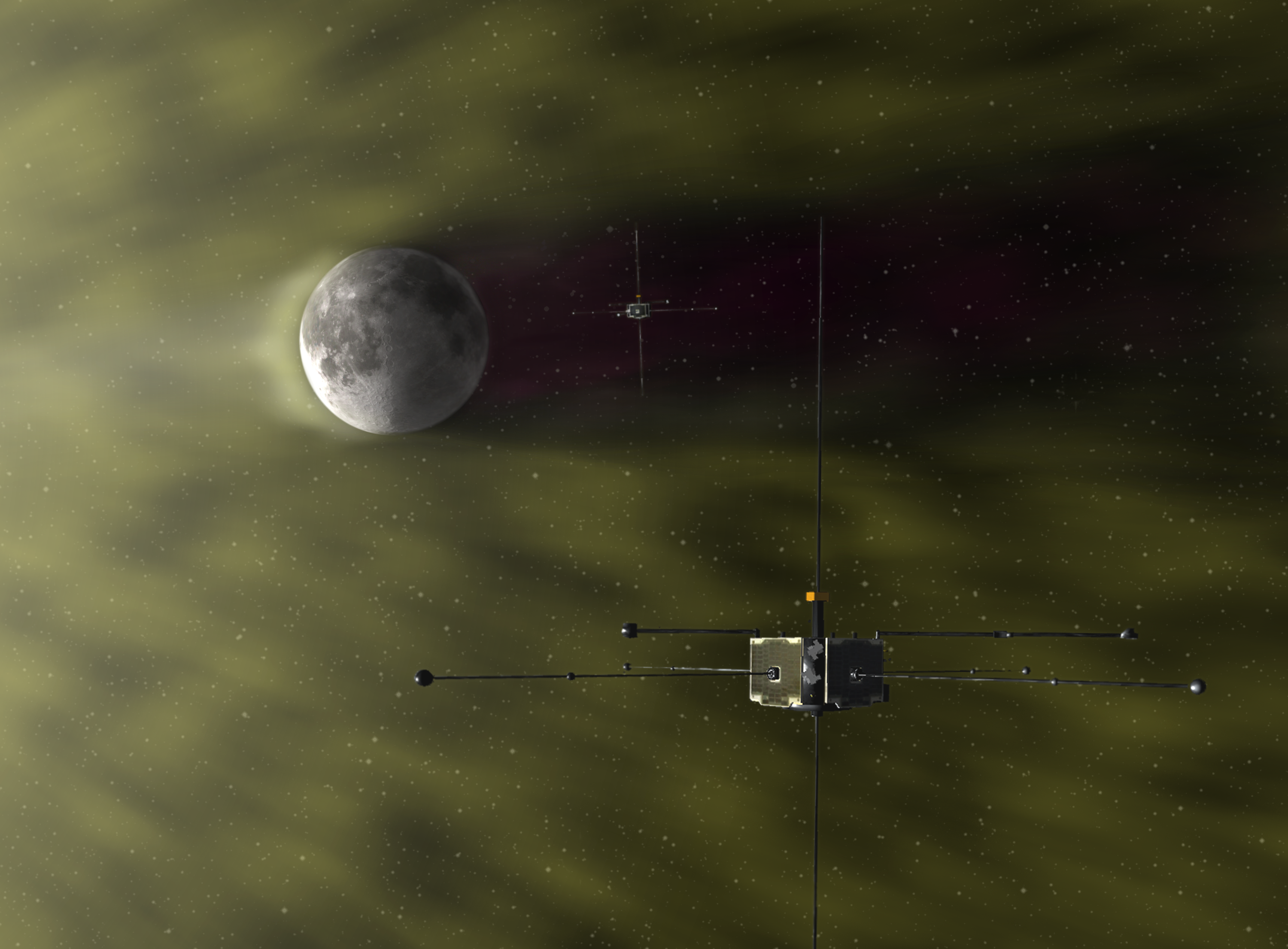 |
| NASA's twin ARTEMIS spacecraft have studied the solar wind's interaction with the Moon, including the lunar wake that distorts nearby magnetic fields. Credits: E. Masongsong, UCLA EPSS |
One Mission into Two
The five THEMIS spacecraft were sent into carefully designed orbits that brought them in alignment every four days. After two productive years of discoveries about radiation and particles in the near-Earth environment, the spacecrafts' orbits had significantly precessed, or drifted. Orbit precession is a natural and expected phenomenon for spacecraft that typically doesn't affect scientific studies. But in the case of THEMIS, it meant the spacecraft would no longer align every four days.
| This animation of a substorm shows how particles from the Sun can cause Earth's magnetic field lines to realign and release stored energy and particles, some of which is funneled down into Earth's upper atmosphere, causing the auroras. Credits: NASA/Goddard/Conceptual Image Lab (Download in HD) |
Knowing the orbits would eventually precess, the THEMIS scientists, in a joint effort coordinated through NASA and the Space Sciences Lab at the University of California, Berkeley, decided in advance to do something new with two of the spacecraft. Instead of spending the remaining fuel to reset the orbits, they'd send them off in a radically new direction — to the Moon.
“NASA's Jet Propulsion Laboratory and Goddard Space Flight Center did some wonderful orbit navigation design for us and came up with these very clever orbits that allowed us to get to the Moon,” Halekas said. “And we're still there.”
Thus, the THEMIS-ARTEMIS mission was born. The mission's acronym was created to reflect its science and position at the Moon, since in Greek mythology, Artemis was goddess of the Moon. Artemis was also the twin of Apollo. NASA Administrator Jim Bridenstine recently named the new lunar program Artemis for these reasons, plus the fact that the agency will send the first woman to the Moon as part of the program.
“THEMIS-ARTEMIS is NASA's only long-term monitor of conditions in and around the lunar environment,” said David Sibeck, THEMIS project scientist at NASA's Goddard Space Flight Center in Greenbelt, Maryland.
| A series of complex maneuvers, created through a joint effort of NASA and UCB's Space Sciences Lab, sent two of the THEMIS spacecraft into orbit around the Moon to initiate the THEMIS-ARTEMIS mission. Credits: NASA's Goddard Space Flight Center (Download in HD) |
Spacecraft Reborn
With the same instruments it used to look for events around Earth, the new mission uses the two spacecraft to learn about how the Moon interacts with the space around it.
“Before THEMIS-ARTEMIS was at the Moon, most people had the idea that the Moon was just a big rock in the sky and it didn't interact a lot with its environment,” Halekas said. “The understanding that we've built up over the last eight years is that the Moon is really connected to the space environment around it. The space environment affects the Moon and vice versa.”
Over the years scientists have made discoveries about the solar wind and its impact on the Moon's surface, interplanetary electromagnetic fields, the structure of the lunar interior, and the particles in the tenuous lunar atmosphere and ionosphere.
| Research using data from NASA's ARTEMIS mission suggests how the solar wind and the Moon's crustal magnetic fields work together to give the Moon a distinctive pattern of darker and lighter swirls. Credits: NASA's Goddard Space Flight Center (Download in HD) |
Working Together
In addition to furthering our understanding of the Moon, the measurements THEMIS-ARTEMIS has made will be useful for upcoming missions, including the Artemis program.
“When we're designing robotic systems and systems for humans on the Moon, we have to understand the conditions they'll be exposed to,” Halekas said. “The measurements from THEMIS-ARTEMIS have helped us find what those conditions are and how they change with time.”
THEMIS-ARTEMIS could provide real-time measurements of highly energetic particles that can be hazardous to spacecraft and astronauts. It will also provide valuable information for instruments placed on the lunar surface. Just like a weather satellite can provide information about incoming storms, THEMIS-ARTEMIS can give information about the space environment to help contextualize discoveries made on the surface.
“THEMIS-ARTEMIS would be a natural partner for any heliophysics mission that is sent to the Moon either on a spacecraft or on the lunar surface,” Sibeck said. “Both spacecraft are working just fine, taking their full sets of measurements, and could last for a very, very long time in that environment.”
As part of the Commercial Lunar Payload Services initiative under the Artemis program, NASA will send a suite of new instruments and technology demonstrations to study the Moon ahead of a human return. The first two lunar deliveries on commercial landers are targeted to launch in July 2021. While many of these investigations focus on lunar science, some hark back to THEMIS's roots in the science of heliophysics, the study of the Sun's interaction with the solar system. The Lunar Surface Electromagnetics Experiment, or LUSEE instrument, will look at electromagnetic phenomena on the lunar surface. The Lunar Environment heliospheric X-ray Imager, or LEXI instrument, will plant a telescope on the Moon to study the Earth's magnetosphere and its interaction with the solar wind.
In the coming years, THEMIS-ARTEMIS, like the agency's Lunar Reconnaissance Orbiter, will continue to provide valuable information to NASA as preparations continue to send astronauts forward to the Moon, and ultimately on to Mars.
Source:Johnson-Groh, M. (2019), Artemis, meet ARTEMIS: Pursuing Sun Science at the Moon, NASA News, Oct. 7 2019.
Aug 22, 2019:
2019 Recipient of AGU Macelwane Medal:
Congrats to Anton Artemyev who was awarded the 2019 AGU Macelwane Medal. It recognizes significant contributions to the geophysical sciences by an outstanding early career scientist. Specifically, Anton was honored "for pioneering work on wave-particle interactions; stability of and particle dynamics within current sheets; and extraordinary mentorship and service."
Anton worked at IKI on theory of non-linear particle dynamics, current sheet stability, and waves (aiding interpretation of Cluster and other ESA missions). His research has expanded in the last few years at UCLA on topics such as solar wind current sheets and the nature of the distant tail magnetopause with ARTEMIS, non-linear oblique whistlers and current carriers in thin current sheets using THEMIS, and HSO correlative studies of discontinuities and reconnection. He pursues these and older topics with students and collaborators around the world. More info can be found on his website.
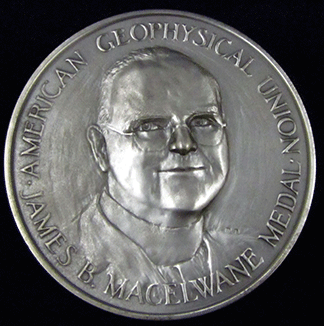 |
| James B. Macelwane Medal |
Established in 1961, the Macelwane Medal was renamed in 1986 in honor of former AGU president James B. Macelwane (1953–1956). Renowned for his contributions to geophysics, Macelwane was deeply interested in teaching and encouraging young scientists.
Source:AGU Medal Recipients Press Release
About the James B. Macelwane Medal
June 13, 2019:
ARTEMIS observations of solar wind discontinuities in Eos magazine:
Congratulations to Anton Artemyev et al., whose work on solar wind discontinuities using ARTEMIS was chosen as an Eos Research Spotlight. They revealed a dual-layer structure, with an intense, but thin, layer of current flowing within a thicker one. The thin current sheet is highly kinetic, and suggest the presence of electrostatic potential to change the electron behaviors and distributions of the two sides of the discontinuity.
ARTEMIS findings were selected as a Research highlight in Eos magazine. The phrase "solar wind” may conjure up images of streams of protons wafting off the Sun and floating into space like a gentle breeze. But these particles, traveling at upward of 400 kilometers per second, more often resemble a raging, turbulent current, with swirls and eddies.
Some of the most dramatic features of the solar wind are discontinuities, where the magnetic field inside the stream abruptly changes direction.These discontinuities are analogous to wind shear that aircraft encounter in Earth's atmosphere, and similarly, their presence usually means there's more turbulence nearby. Strong electric currents flow near a discontinuity, and these are an important generator of turbulence throughout the solar wind. But investigating these dynamics in detail is not easy and requires data from multiple spacecraft that straddle such a boundary.
Now Artemyev et al. have used data from NASA's Acceleration, Reconnection, Turbulence and Electrodynamics of the Moon's Interaction with the Sun (ARTEMIS) mission, a pair of satellites that orbit the Moon and have a unique vantage point in the pristine solar wind. By mining data from its suite of instruments on the solar wind, its plasma, and its magnetic field, the team identified roughly 300 discontinuities and analyzed their structure.
They found that the currents that accompany solar wind discontinuities are actually two currents in one: They have a dual-layer structure, with an intense, but thin, layer of current flowing within a thicker one. The thin, embedded layer is typically on the order of a few thousand kilometers thick, whereas the weaker outer layer can span hundreds of thousands of kilometers.Intriguingly, the team also found that the behavior of solar wind discontinuities doesn't fit neatly into theoretical categories.
In fluid dynamics theory, discontinuities like those in the solar wind come in two forms. In some, plasma flows in the same direction but at different speeds, so that no plasma flows across the boundary—a so-called tangential discontinuity. In others, the discontinuity is a kind of shock wave, so that plasma can cross the boundary but is sent off in another direction as it does—a rotational discontinuity.
But the discontinuities the team observed look like a combination of both categories. The density and temperature of the solar wind's plasma change dramatically from one side of the discontinuity to another, suggesting a stark, tangential discontinuity where no particles could cross. Yet the team also observed that some electrons—those with energies of hundreds of electron volts or higher—could freely cross over the boundary, as in a rotational discontinuity.
The key to resolving this contradiction may lie in the motion of individual plasma particles as they gyrate through space under the influence of electric and magnetic fields, the authors write. A drop in electric potential could create conditions that appear to create separate groups of plasma—like one layer embedded in another—yet still allow some particles to cross over the discontinuity. Investigating this possibility will require theorists to branch out from treating the solar wind as a pure fluid and to use models that consider the motions of individual particles, the team writes.
Source:Zastrow, M. (2019), Understanding the turbulent nature of the solar wind, Eos, 100, https://doi.org/10.1029/2019EO126329.
Citations:
Artemyev, A. V., Angelopoulos, V., & Vasko, I. Y. ( 2019). Kinetic properties of solar wind discontinuities at 1 AU observed by ARTEMIS. Journal of Geophysical Research: Space Physics, 124. https://doi.org/10.1029/2019JA026597
May 31, 2019:
Astronomy.com highlights NASA moon robots:
ARTEMIS Lunar Probes
LRO isn't NASA's only lunar probe. Another, largely under-the-radar mission, is currently being carried out by a duo of repurposed NASA spacecraft.
The ARTEMIS mission (short for Acceleration, Reconnection, Turbulence, and Electrodynamics of the Moon's Interaction) is a spin-off of a former Earth-orbiting project named THEMIS. The original THEMIS mission saw five identical probes launched into Earth orbit in early 2007.
The probes studied how charged particles streaming from the Sun interact with Earth's magnetic field. At the conclusion of THEMIS' primary mission in 2009, NASA decided to try reassigning two of the craft, which were having trouble keeping power in Earth's shadow. And scientists thought the repurposed spacecraft could help them learn about the magnetic mysteries of the Moon.
The probes performed a series of maneuvers that transferred them from Earth orbit to their intended destinations near the Moon. They've spent the last seven years closely studying how the Moon interacts with the solar wind and Earth's magnetosphere.
For example, researchers have used ARTEMIS to study a mysterious feature of the Moon known as its plasma wake. This is a turbulent cavity in space where the solar wind is blocked by the Moon itself, which can lead to some interesting effects. Plasma wakes can trickle electrical charge onto the lunar surface, presenting a potentially dangerous discharge hazard for the spacesuits of future astronauts.
Researchers are also interested in using ARTEMIS to learn more about an extended region of our planet's magnetic field — called a magnetotail — that the solar wind pushes to well beyond the orbit of the Moon. ARTEMIS discovered that reconnection events in the magnetotail hurl unstable jets of charged particles toward our planet. These particles kickstart auroras on Earth and might endanger travelers headed to the Moon. According to a NASA statement, "The more we understand about how those particles are accelerated, the better we can protect our spacecraft and astronauts as we explore deeper into the solar system."
ARTEMIS isn't done just yet. Earlier this year, it explained the cause of an odd Moon phenomenon described as "sunburn.” On Earth, our magnetic field blocks most particles streaming from the Sun. The Moon doesn't have that protection. And the constant bombardment by high-energy particles darkens the lunar soil. However, even though the Moon doesn't have a global magnetic field, its surface is speckled with magnetized rocks. And these isolated yet relatively weak magnetic fields can span hundreds of miles, providing bubbles of protection from the solar wind.
"The magnetic fields in some regions are locally acting as this magnetic sunscreen," Andrew Poppe of UC-Berkeley, who uses ARTEMIS data to study the Moon's surface magnetic fields, said in press materials. "Sometimes you put on sunscreen and you miss a tiny little bit, and then you have a really bright red spot on your skin."
A similar process is happening on the Moon. As the charged particle stream toward the surface, they are deflected around the localized magnetic bubbles, leaving distinct light splotches of unadulterated regolith. Although such magnetic hotspots are too weak to shield future lunar astronauts from all the dangers of the solar wind, by studying their structure, researchers hope to develop more effective ways of protecting the next wave of explorers from radiation as they tread across the surface of the Moon.
Citation:Parks, J., The NASA robots scouting out the Moon, Astronomy.com
May 16, 2019:
Lunar wake modeling using ARTEMIS data chosen as GRL cover:
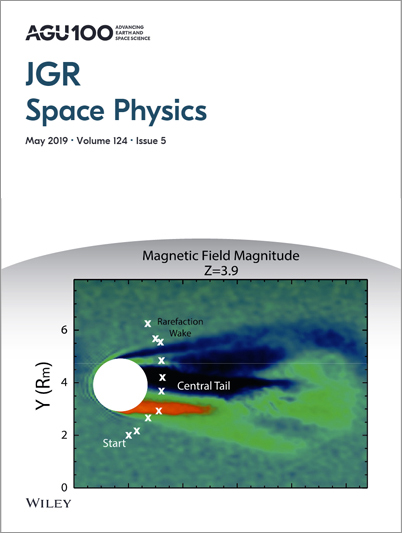 |
| Hybrid simulation of the plasma environment around the Moon. Credit: N. Omidi et al. |
Congrats to Omidi et al., whose lunar wake modeling data was chosen as cover of JGR. Using the results of 3-D electromagnetic hybrid (kinetic ions and fluid electrons) simulations and observations by the THEMIS/ARTEMIS spacecraft, they investigate the nature of the solar wind interaction with the moon and the resulting wake and tail structure. In the absence of a global magnetic field and an atmosphere at the moon, this interaction is due to the absorption of the solar wind plasma on the dayside and the means by which the resulting cavity in the tail is refilled. To explore this process, they conducted simulations of specific case studies well-monitored by the ARTEMIS spacecraft.
Citation:Omidi, N., Zhou, X. Y., Russell, C. T., & Angelopoulos, V. ( 2019). The dominant role of energetic ions in solar wind interaction with the moon. Journal of Geophysical Research: Space Physics, 124, 3176– 3192. https://doi.org/10.1029/2018JA026243
February 27, 2019:
NASA News describes ARTEMIS mission, reveals origins of moon's "sunburn":
Every object, planet or person traveling through space has to contend with the Sun's damaging radiation — and the Moon has the scars to prove it. Research using data from NASA's ARTEMIS mission — short for Acceleration, Reconnection, Turbulence and Electrodynamics of the Moon's Interaction with the Sun — suggests how the solar wind and the Moon's crustal magnetic fields work together to give the Moon a distinctive pattern of darker and lighter swirls.
| Research using data from NASA's ARTEMIS mission suggests how the solar wind and the Moon's crustal magnetic fields work together to give the Moon a distinctive pattern of darker and lighter swirls. Credits: NASA's Goddard Space Flight Center |
The Sun releases a continuous outflow of particles and radiation called the solar wind. The solar wind washes over the planets, moons and other bodies in our solar system, filling a bubble of space — called the heliosphere — that extends far past the orbit of Pluto.
Here on Earth, we're largely protected from the damaging effects of the solar wind: Because the solar wind is magnetized, Earth's natural magnetic field deflects the solar wind particles around our planet so that only a small fraction of them reach our planet's atmosphere.
But unlike Earth, the Moon has no global magnetic field. However, magnetized rocks near the lunar surface do create small, localized spots of magnetic field that extend anywhere from hundreds of yards to hundreds of miles. This is the kind of information that needs to be well understood to better protect astronauts on the Moon from the effects of radiation. The magnetic field bubbles by themselves aren't robust enough to protect humans from that harsh radiation environment, but studying their structure could help develop techniques to protect our future explorers.
"The magnetic fields in some regions are locally acting as this magnetic sunscreen," said Andrew Poppe, a scientist at the University of California, Berkeley, who researches the Moon's crustal magnetic fields using data from NASA's ARTEMIS mission along with simulations of the Moon's magnetic environment.
These small bubbles of magnetic "sunscreen" can also deflect solar wind particles — but on a much smaller scale than Earth's magnetic field. While they aren't enough to protect astronauts by themselves, they do have a fundamental effect on the Moon's appearance. Under these miniature magnetic umbrellas, the material that makes up the Moon's surface, called regolith, is shielded from the Sun's particles. As those particles flow toward the Moon, they are deflected to the areas just around the magnetic bubbles, where chemical reactions with the regolith darken the surface. This creates the distinctive swirls of darker and lighter material that are so prominent they can be seen from Earth — one more piece of the puzzle to help us understand the neighbor NASA plans to re-visit within the next decade.
Source:NASA Mission Reveals Origins of Moon's 'Sunburn'
Citations:
Poppe, A. R., J. S. Halekas, C. Lue, and S. Fatemi (2017), ARTEMIS observations of the solar wind proton scattering function from lunar crustal magnetic anomalies, J. Geophys. Res. Planets, 122, 771–783, doi:10.1002/2017JE005313.
Poppe, A.R., S. Fatemi, I. Garrick-Bethell, D. Hemingway, M. Holstrom (2016), Solar wind interaction with the Reiner Gamma crustal magnetic anomaly: Connecting source magnetization to surface weathering, Icarus, 266, 261-66, https://doi.org/10.1016/j.icarus.2015.11.005.
December 13, 2018:
ARTEMIS paper featured on JGR Space Physics website:
Congratulations to Gedalin et al., whose paper "Ion Dynamics and the Shock Profile of a Low-Mach Number Shock" was featured on the JGR Space Physics website. They used ARTEMIS P2 (THC) measurements of the fluctuating magnetic field detected at low-Mach number shocks. Separation of the essential shock profile from features superimposed on it is one of the basic problems of shock physics. The study authors achieved this separation by using a combined analytical-numerical-simulative analysis. They show that the macroscopic fields of the shock play the main role in the formation of downstream ion distributions. The measured ion distributions from ARTEMIS/ESA agree well with the theoretically predicted onset of the anisotropy at the shock crossing and its persistence well into the downstream region.
Citation:
Gedalin, M., Zhou, X., Russell, C. T., Drozdov, A. Y., Liu, T. Z. (2018). Ion dynamics and the shock profile of a low‐Mach number shock. Journal of Geophysical Research: Space Physics, 123, 8913–8923. https://doi.org/10.1029/2018JA025945
http://www.astronomy.com/news/2019/05/the-nasa-robots-scouting-out-the-moon
November 30, 2018:
NASA News highlights ARTEMIS' exosphere investigations:
New Insight at the Moon
Returning to the Moon will undoubtedly unlock new doors to understanding our nearest neighbor in space. After all, it wasn't until we first stepped foot on the Moon that we were able to understand its origins. Today we are still discovering new things and NASA missions like the Acceleration, Reconnection, Turbulence, and Electrodynamics of Moon's Interaction with the Sun — ARTEMIS — are uncovering new insights into the Moon's tenuous atmosphere.
The Moon is, in fact, not airless. It has a thin atmospheric layer — the exosphere — composed mainly of hydrogen, helium, neon and argon, extends about a hundred miles above the surface. Mixed on the upper edge of the exosphere is a tenuous and ephemeral secondary layer — the ionosphere — created by sunlight energizing atoms in the exosphere.
"The ionosphere is a million times less dense than the ionosphere of Earth so it's really hard to directly measure those charged particles,” said Jasper Halekas, ARTEMIS scientist at the University of Iowa in Iowa City, and lead author on a new study of the Moon's ionosphere.
Using a new technique to analyze data from ARTEMIS, Halekas and his team were able to measure the ionosphere directly. They noted the ionosphere enlarged every full Moon and became coupled with Earth's ionosphere — meaning charged particles are likely able to travel back and forth between the two bodies' ionospheres.
"The presence of the Moon may actually affect Earth's magnetosphere,” Halekas said. "It might actually perturb that local environment.”
New missions to the Moon would allow the study of the ionosphere and exosphere from the surface, giving us a better understanding of that coupling and how our atmosphere may be linked with the Moon's.
The new results might also help us better understand how atmospheres are created and sustained on small bodies.
"The same technique could be applied to lots of other bodies in the solar system, which should have a tenuous atmosphere like the Moon's,” Halekas said. "This would include: moons around the outer planets, big bodies in the asteroid belt, things in the Kuiper belt, and even objects outside the solar system.”
Source: Johnson-Groh, Mara. Charting a Course for Astronaut Safety as NASA Launches to the Moon and to Mars, Moon to Mars, Nov. 2018.September 18, 2018:
ARTEMIS lunar ionosphere discovery profiled in National Geographic:
Congratulations to Halekas et al., whose GRL paper titled: "A tenuous lunar ionosphere in the geomagnetic tail" was featured in National Geographic magazine. Their new study reminds us that our pale celestial guardian is more dynamic than it seems from afar. Fresh measurements of its flimsy atmosphere back up the idea that our lunar companion is surrounded by an electric shell, and that shell seems to gather power when Earth shields it from the fury of the sun during a full moon. In effect, when you gaze at a bright full moon shining in the sky, you are probably seeing the lunar orb at its most electric.
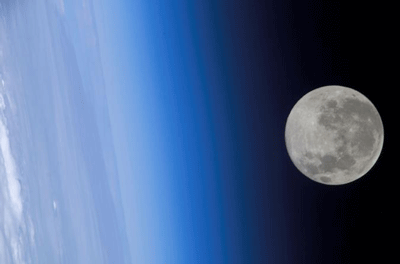 |
| A full moon seems to brush Earth's atmosphere as seen from the International Space Station. (Credit: NASA) |
The full moon lies within the elongated tail of Earth's magnetic field. This means the moon and the faint husk of the lunar ionosphere are shielded from much of the highly energetic solar wind that constantly streams into deep space. During this critical window, ARTEMIS could track the plasma waves emerging from the sunlight-bombarded lunar dayside and create a much more detailed picture of the moon's ionosphere. This was the first time such an incredibly precise technique has been used on the moon, and it revealed that the lunar ionosphere is about a million times more tenuous than Earth's.
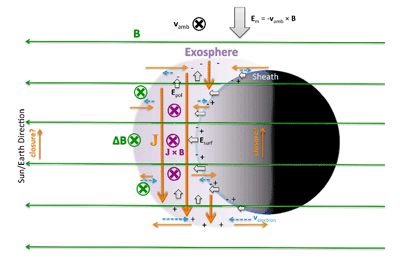 |
| Schematic illustration of the plasma flows, electromagnetic fields, and electric currents around the Moon in thegeomagnetic tail. |
Weak though it may be, the lunar-derived plasma has appreciably higher density while in this refuge than the density of the plasma surrounding it. This suggests that the moon's ionosphere becomes more prominent when it's in Earth's protection. Halekas describes this relative ionospheric peak as "a little source of plasma bubbling and seething around the moon." Crucially, this means that the lunar plasma can measurably perturb the plasma coming from Earth and the sun, leading to observable changes in electrical currents and the distribution of electrons around the region. It's possible that there's even a plasma-based connection between Earth and the moon, and previous research offers some tentative evidence that such a particle exchange exists.
Source: Andrews, Robin G. (2018), The Moon Is Electric—Especially When It's Full, NationalGeographic.com. Published on Sept. 18 2018.Citation: Halekas, J. S., Poppe, A. R., Harada, Y., Bonnell, J. W., Ergun, R. E., & McFadden, J. P. (2018). A tenuous lunar ionosphere in the geomagnetic tail. Geophysical Research Letters, 45. https://doi.org/10.1029/2018GL079936
July 20, 2018:
ARTEMIS observes Kelvin-Helmholtz waves in Earth's magnetic field, spotlight in Eos Magazine:
ARTEMIS research explaining the Kelvin-Helmholtz instability was selected as a Research Highlight in Eos. The instability arises where there's a difference in velocity at the boundary between two fluids—like wind blowing across water—. This can create Kelvin-Helmholtz waves (KHWs), which look like a series of rolling breakers hitting the beach. KHWs are frequently observed along the outermost boundary of Earth's magnetic field, where they presumably help transfer energy and plasma from the solar wind into our planet's magnetosphere. Yet the conditions under which these waves form and how they evolve over time are still poorly understood.
 |
| This artist rendering shows how Kelvin-Helmholtz instability waves in Earth's magnetic tail might propagate through time and space. Credit: Quanqi Shi |
To better characterize KHWs, Ling et al. used the Acceleration, Reconnection, Turbulence, and Electrodynamics of Moon's Interaction with the Sun (ARTEMIS) and Geotail satellites to make simultaneous observations of the waves from opposite sides of Earth's magnetic tail during an instability event that occurred between 13 and 14 March 2014. They then compared their point measurements with computer simulations of the magnetosphere's response to the solar wind conditions observed during the same period of time.
The results offer evidence that KHWs develop in Earth's magnetic tail and that their wavelengths increase as they move tailward along the boundary layer, a finding that agrees with previously published simulations. The observations also suggest that vortices created by the instability develop at roughly the same time on the tail's dawn and dusk sides, although slight differences between the two sets of satellite observations prevented the researchers from completely ruling out dusk-dawn asymmetry.
In addition to providing new observational evidence for the growth of KHWs in Earth's magnetic tail, these findings provide insight into how this crucial means of interspace energy transfer evolves through both time and space. (Journal of Geophysical Research: Space Physics, https://doi.org/10.1029/2018JA025183, 2018)
Eos Research Spotlight: Cook, T. (2018), Measurements of Kelvin-Helmholtz waves in Earth's magnetic field, Eos, 99, https://doi.org/10.1029/2018EO101199. Published on 20 July 2018.Citation: Ling, Y., Shi, Q., Shen, X.‐C., Tian, A., Li, W., Tang, B., et al. (2018). Observations of Kelvin‐Helmholtz waves in the Earth's magnetotail near the lunar orbit. Journal of Geophysical Research: Space Physics, 123, 3836–3847. https://doi.org/10.1029/2018JA025183
March 21, 2018:
ARTEMIS data on "Magnetic-less" Magnetotail Boundary highlighted in Eos:
Congratulations to Anton Artemyev, whose JGR paper titled: “Properties of the Equatorial Magnetotail Flanks ∼50–200 RE Downtail” was selected as AGU Editors' Highlight. The authors examine a crossings of the magnetotail boundary (magnetopause) at lunar distances and find that the magnetic field at that distance plays a minor role in separating the two populations, the magnetospheric and magnetosheath. This is completely different from the dayside magnetopause, which is dominated by a magnetic field discontinuity. They find that the total energies of the ion populations inside and outside the boundary are similar, suggesting thermalization is sufficient to convert streaming magnetosheath ions into hot, rarified magnetotail ions inside the boundary.
Most boundaries in space are governed by magnetic fields, but not far behind the Earth, where the field change across the magnetopause plays very little role in the pressure balance relationship.
Space physicists like to focus on regional boundaries that are magnetized. Artemyev et al. [2017] examine a boundary where magnetic fields play only a marginal role: the far-downtail magnetopause. At distances from 50 to 200 RE downtail, they find that the pressure balance is dominated by the plasma on each side of the boundary, not the magnetic field change across the boundary. This is completely different from the dayside magnetopause, which is dominated by a magnetic field discontinuity. They find that the total energies of the ion populations inside and outside the boundary are similar, suggesting thermalization is sufficient to convert streaming magnetosheath ions into hot, rarified magnetotail ions inside the boundary.
Eos Editor's Highlight: Liemohn, M., The "Magnetic-less" Magnetotail Boundary, Eos, January 2018Citation: Artemyev A.V, V. Angelopoulos, A. Runov, C.-P. Wang, and L.M. Zelenyi [2017], Properties of the equatorial magnetotail flanks 50-200RE downtail, Journal of Geophysical Research: Space Physics, 122, https://doi.org/10.1002/2017JA024723
October 17, 2017:
ARTEMIS Observes Waves Growing in near-Earth Space:
Congrats to Dorfman et al., whose ARTEMIS findings were highlighted at the 59th annual meeting of the APS Division of plasma Physics. Earth has its own shield, in the form of our planet's magnetic field, that protects us from the hot, charged material called "plasma" constantly being hurled at us by the sun. When this fast-moving plasma hits Earth's magnetic shield, a bow shock is formed. Just like the curve of water that bends to the side in front of a moving ship, the bow shock is where hot plasma is deflected to the side, leaving us on Earth unaffected. However, a very small portion of the plasma bounces straight back towards the sun.
 |
| Artist depiction of the solar wind plasma (yellow) interacting with the Earth's magnetosphere (purple) to form the bow shock front (light blue). |
These reflected particles interact with the plasma coming from the sun and make waves. The waves get carried with the plasma towards Earth, making it through the shield where they reach the region of space near our planet.
For the first time, scientists at the University of California, Los Angeles and the Max Planck Institute for Plasma Physics in Germany have been able to see these waves grow in the region of space where they were formed. They did so using satellites that only recently moved into a prime spot for the measurement. Before 2010, a five spacecraft mission called THEMIS was orbiting Earth. In 2010, two spacecraft split off and started orbiting the Moon, and the mission was renamed ARTEMIS. When the moon passes between the Earth and sun, ARTEMIS sees the the small portion of particles that bounce back from the bow shock; these particles are responsible for generating the waves.
"The two ARTEMIS spacecraft are ideally located for this measurement," said Seth Dorfman, the lead author of the study. "Close to the bow shock, the waves can come from many places at once, but it's easier to identify the wave source out near the moon. This enables a clear measurement of the waves."
These waves are not just a curiosity – they can affect us here on Earth. When the waves run into the region of space around Earth, they can cause disturbances in Earth's magnetic field all the way to the ground. Strong disturbances or "space weather" may damage our sensitive infrastructure, such as communication satellites and power grids. Much like advances in weather forecasting let us know when to get out of the wave of a hurricane, studies of how these waves behave may help us protect our satellites and power grids from space weather damage.
Source: 59th Annual Meeting of the American Physical Society, Division of Plasma Physics, Press ReleaseCitation: Dorfman, H. Hietala, P. Astfalk, and V. Angelopoulos, "Growth Rate Measurement of ULF Waves in the Ion Foreshock," Geophys. Res. Let. 44 (2017).
August 21, 2017:
ARTEMIS has a front row seat for The Great American Eclipse:
Millions will be watching the Sun and the Moon on Monday, but only a small number of observers know about our two little "cheerleaders" that accompany the Moon!
THEMIS C (ARTEMIS P2) will be leading and THEMIS B (ARTEMIS P1) will be following the Moon across the solar disk. As seen from Salem, OR, THEMIS C will be passing near the center of the Sun at 13:03:40 UTC (actually about 17 min before local sunrise), and THEMIS B will be passing just below the solar disk at 21:40:50 UTC.
Here is a link to a small animation:
Video courtesy of Manfred Bester, UC Berkeley SSL.
May 31, 2017:
THEMIS and ARTEMIS highlighted in Scientia:
THEMIS, ARTEMIS and the soon to be launched cubesat ELFIN were profiled in Scientia Magazine. The special issue entitled "From Climate Change to the Cosmic Web," covers many facets of geophysical, atmospheric, and solar-terrestrial processes that affect our society. The issue also features other space weather researchers including an interview with our very own Project Scientist, David Sibeck: "It really is a great time to be a researcher in our community. Probably the biggest challenge facing researchers in our field is choosing which of the many fascinating areas to work on."
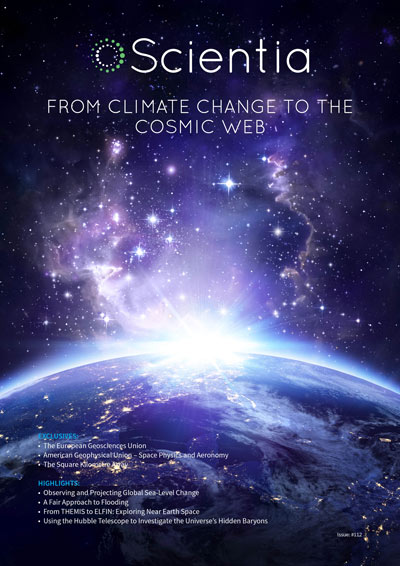 |
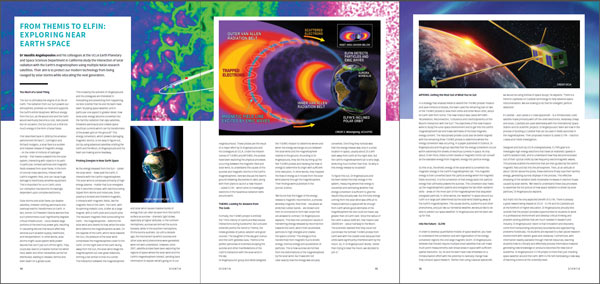 |
Link: Berg, N., et al., "From THEMIS to ELFIN, Exploring Near-Earth Space," Scientia 112, May 2017: 94-97.
March 9, 2017:
ARTEMIS measurements of magnetic reconnection jets featured in NASA News:
Every day, invisible magnetic explosions are happening around Earth, on the surface of the sun and across the universe. These explosions, known as magnetic reconnection, occur when magnetic field lines cross, releasing stored magnetic energy. Such explosions are a key way that clouds of charged particles -- plasmas -- are accelerated throughout the universe. In Earth's magnetosphere -- the giant magnetic bubble surrounding our planet -- these magnetic reconnections can fling charged particles toward Earth, triggering auroras.
Magnetic reconnection, in addition to pushing around clouds of plasma, converts some magnetic energy into heat, which has an effect on just how much energy is left over to move the particles through space. A recent study used observations of magnetic reconnection from NASA's ARTEMIS -- Acceleration, Reconnection, Turbulence and Electrodynamics of the Moon's Interaction with the Sun -- to show that in the long tail of the nighttime magnetosphere, extending away from Earth and the sun, most of the energy is converted into heat. This means that the exhaust flows -- the jets of particles released by reconnection -- have less energy available to accelerate charged particles than previously thought.
When magnetic reconnection occurs between two clouds of plasma that have the same density, the exhaust flow is wildly unstable -- flapping about like a garden hose with too much water pressure. However, the new results find that, in the event observed, if the plasmas have different densities, the exhaust is stable and will eject a constant, smooth jet. These differences in density are caused by the interplay of the solar wind -- the constant stream of charged particles from the sun -- and the interplanetary magnetic field that stretches across the solar system. These new results are key to understanding how magnetic reconnection can send particles zooming toward Earth, where they can initiate auroras and cause space weather. Such information also provides fundamental information about what drives movement in space throughout the universe, far beyond the near-Earth space we can observe more easily. The ARTEMIS spacecraft are working in tandem with other missions like Time History of Events and Macroscale Interactions during Substorms, and Magnetospheric Multiscale to form a complete picture of magnetic reconnection near Earth.Sources:
NASA Press Release
Hietala, H., A. V. Artemyev, and V. Angelopoulos (2017), Ion dynamics in magnetotail reconnection in the presence of density asymmetry, J. Geophys. Res. Space Physics, 122, doi:10.1002/2016JA023651.
July 12, 2016:
ARTEMIS observes heavy ions escaped from Earth's ionosphere, GRL highlight:
Recent ARTEMIS observations of rare, terrestrial heavy ion outflow at the moon were featured as an Editor's Highlight in the journal Geophysical Research Letters. Poppe et al. report charged particles (molecular ions. N2+, NO+, O2+) flowing down the Earth's magnetotail past the Moon. These heavy ions originate from the Earth's ionosphere during strong geomagnetic storms, and can be energized and injected into Earth's magnetosphere. The ions circulate within Earth's magnetic fields, before finding an "escape route." This escape route takes them away from the Earth and they pass by the Moon on their way out. Observations of these escaping molecular ions are relatively rare. ARTEMIS data provide an exciting opportunity to learn more about how Earth loses part of its atmosphere to space, made possible by the satellites' distant perspective around the Moon.
Sources:
GRL Editor's Highlight
ARTEMIS Nugget Summary
Poppe, A. R., M.O. Fillingim, J. S. Halekas, J. Raeder, and V. Angelopoulos (2016), ARTEMIS observations of terrestrial molecular ion outflow at the Moon, Geophys. Res. Lett., 43, doi:10.1002/2016GL069715.
April 4, 2016:
ARTEMIS lunar plasma waves featured in new book:
In their new book, the editors have compiled a collection of review chapters written by leading experts on the topic of low-frequency waves in space plasmas. While in the past waves in different astrophysical plasmas have been largely treated in separate books, the unique feature of this book is that it covers waves occurring in many plasma regions of our Solar System. Organized into ten parts, each representing a specific space region, the book begins with waves at Earth's ionosphere and progresses outward to various regions of Earth's magnetosphere. Then, beyond geospace, waves in the solar wind, at the Moon, and at other planets' magnetospheres are reviewed. Finally, the book finishes with waves in the Sun's atmosphere.
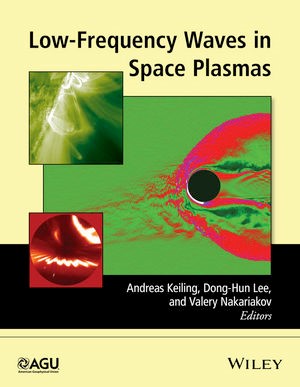 |
THEMIS and ARTEMIS results are integral parts of many chapters, including those reviewing waves at the Moon, Earth's ionosphere and magnetosphere, and the solar wind.
January 15, 2015:
JGR Editor's Highlight, ARTEMIS 3D Lunar Wake Observations:
Unlike the Earth, whose magnetic field deflects much of the incoming solar wind, the surface of the Moon absorbs most of the particles that the Sun sends its way. This creates a void behind the moon that gradually refills with plasma, forming a cone-shaped "lunar wake." However, the processes that govern refilling remain unclear, although models suggest they probably include a mixture of kinetic effects and effects particular to the dynamics of electrically conducting fluids.
Zhang et al. now provide a detailed characterization of the lunar wake and its relationship to the direction and strength of the solar wind. The researchers used two years' worth of data from the Acceleration, Reconnection, Turbulence, and Electrodynamics of the Moon's Interaction with the Sun (ARTEMIS) mission to characterize many physical properties of the wake, including its magnetic properties, ion and electron densities, temperatures, pressures, and flow, while simultaneously monitoring the solar wind.
The scientists find that the lunar wake trails behind the Moon out to a distance at least 12 times its radius. The edges of the wake generate density waves that form disturbances that propagate both outward and inward like the wake of a boat. This process can mostly be explained by known principles about the flow of plasma. In contrast, they find that kinetic effects most likely explain the mid-wake maximum in ion and electron temperatures, which may result from high-energy particles refilling the wake faster than their low-energy counterparts.
Notably, the researchers find that the angle between the direction of the solar wind and the orientation of the interplanetary magnetic field also influence the shape and character of the lunar wake, making it more ring-like for angles close to parallel and flatter for more perpendicular configurations. The scientists also find that the interplanetary magnetic field itself bulges toward the Moon inside the lunar wake, although they can't yet identify the mechanism behind this observation.
Sources:
Wendel, J. (2014), Satellite data yields detailed picture of the lunar wake, Eos. Trans. AGU, in press.
Zhang, H., K. K. Khurana, M. G. Kivelson, V. Angelopoulos, W. X. Wan, L. B. Liu, Q.-G. Zong, Z. Y. Pu, Q. Q. Shi, and W. L. Liu (2014), Three-dimensional lunar wake reconstructed from ARTEMIS data, J. Geophys. Res. Space Physics, 119, 5220–5243, doi:10.1002/2014JA020111.
April 8, 2014:
ARTEMIS and LADEE missions synergize to explain lunar dust:
 |
| Notional view of the LADEE and ARTEMIS spacecraft superimposed on Clementine star-tracker imagery from 1994 [NASA/DOD/JPL-Caltech]. |
ARTEMIS' contributions to the Lunar Atmosphere Dust Environment Explorer (LADEE) mission were highlighted in the recent issue of AGU's Eos journal. The feature reveals some of their preliminary results on the moon's dust and plasma environment, presented at the 45th Lunar and Planetary Science Conference in March 2014.
LADEE's primary mission to study the the distribution, sources, and sinks of lunar atmospheric dust is nearing completion, after 6 months in orbit. UCB SSL's Jasper Halekas stressed the importance of multi-spacecraft observations of the solar wind at the moon, where ARTEMIS observations of helium were used to corroborate LADEE measurements. This is the first use of dedicated space weather satellites to better understand planetary phenomena, specifically the tenuous dust at the moon that may be the most common type of atmosphere in our solar system.
With ARTEMIS data, Halekas attempted to calculate the total supply of helium at the Moon, delivered by the solar wind. He then compared this with data from LADEE and got matching results. "I submit to you that this is the best correlation you can ever get between two different spacecraft that collect two completely different kinds of measurements," Halekas said.
LADEE will conclude it's mission in the coming weeks by impacting the lunar surface, which will allow the craft to make critical low-altitude observations. Congrats to the LADEE and ARTEMIS teams for their hard work, and we look forward to their forthcoming publications explaining the phenomenon of atmospheric dust.
September 27, 2013:
ARTEMIS unravels energy conversion at reconnection fronts:
The twin ARTEMIS probes' lunar vantage point was key to unraveling energy conversion in Earth's magnetosphere, as reported in the recent journal Science. With an unprecedented alignment of 8 spacecraft including THEMIS, Geotail and GOES, researchers from UCLA, JAXA, and Austrian IWF observed reconection fronts moving towards Earth and away beyond the moon.
Solar storms — powerful eruptions of solar material and magnetic fields into interplanetary space — can cause what is known as "space weather" near Earth, resulting in hazards that range from interference with communications systems and GPS errors to extensive power blackouts and the complete failure of critical satellites.
New research published today increases our understanding of Earth's space environment and how space weather develops.
Some of the energy emitted by the sun during solar storms is temporarily stored in Earth's stretched and compressed magnetic field. Eventually, that solar energy is explosively released, powering Earth's radiation belts and lighting up the polar skies with brilliant auroras. And while it is possible to observe solar storms from afar with cameras, the invisible process that unleashes the stored magnetic energy near Earth had defied observation for decades.
In the Sept. 27 issue of the journal Science, researchers from the UCLA College of Letters and Science, the Austrian Space Research Institute (IWF Graz) and the Japan Aerospace Exploration Agency (JAXA) report that they finally have measured the release of this magnetic energy close up using an unprecedented alignment of six Earth-orbiting spacecraft and NASA's first dual lunar orbiter mission, ARTEMIS.
Space weather begins to develop inside Earth's magnetosphere, the giant magnetic bubble that shields the planet from the supersonic flow of magnetized gas emitted by the sun. During solar storms, some solar energy enters the magnetosphere, stretching the bubble out into a long, teardrop-shaped tail that extends more than a million miles into space.The stored magnetic energy is then released by a process called "magnetic reconnection." This event can be detected only when fast flows of energized particles pass by a spacecraft positioned at exactly the right place at the right time. Luckily, this happened in 2008, when NASA's five Earth-orbiting THEMIS satellites discovered that magnetic reconnection was the trigger for near-Earth substorms, the fundamental building blocks of space weather. However, there was still a piece of the space weather puzzle missing: There did not appear to be enough energy in the reconnection flows to account for the total amount of energy released for typical substorms.
In 2011, in an attempt to survey a wider area of the Earth's magnetosphere, the THEMIS team repositioned two of its five spacecraft into lunar orbits, creating a new mission dubbed ARTEMIS after the Greek goddess of the hunt and the moon. From afar, these two spacecraft provided a unique global perspective of energy storage and release near Earth.
Similar to a pebble creating expanding ripples in a pond, magnetic reconnection generates expanding fronts of electricity, converting the stored magnetic energy into particle energy. Previous spacecraft observations could detect these energy-converting reconnection fronts for a split second as the fronts went by, but they could not assess the fronts' global effects because data were collected at only a single point. By the summer of 2012, however, an alignment among THEMIS, ARTEMIS, the Japanese Space Agency's Geotail satellite and the U.S. National Oceanic and Atmospheric Administration's GOES satellite was finally able to capture data accounting for the total amount of energy that drives space weather near Earth. During this event, reported in the current Science paper, a tremendous amount of energy was released.
The amount of power converted was comparable to the electric power generation from all power plants on Earth — and it went on for over 30 minutes. The amount of energy released was equivalent to a 7.1 Richter-scale earthquake. Trying to understand how gigantic explosions on the sun can have effects near Earth involves tracking energy from the original solar event all the way to Earth. It is like keeping tabs on a character in a play who undergoes many costume changes, researchers say, because the energy changes frequently along its journey: Magnetic energy causes solar eruptions that lead to flow energy as particles hurtle away, or to thermal energy as the particles heat up. Near Earth, that energy can go through all the various changes in form once again. Understanding the details of each step in the process is crucial for scientists to achieve their goal of someday predicting the onset and intensity of space weather.
Visualization of reconnection fronts, courtesy. J. Raeder/UNH
Sources:
UCLA Press Release- Lunar orbiters discover source of space weather near Earth
Featured extensively in international media, including: Space.com, NBC News, Yahoo News, Science Magazine News, Science Daily, Phys.org, ScienceBlog.org, EurekAlert (AAAS), Environmental News Network, Red Orbit, Times of India, French Tribune, Le Scienze (Italy), and Newspoint Africa.
March 28, 2013:
THEMIS/ARTEMIS International Team Sees Auroras:
The Spring THEMIS-ARTEMIS Science Working Group meeting brought researchers together from all over the world to share the latest findings on the magnetosphere, solar wind, and the moon. Even better, attendees were rewarded with a substorm and brilliant auroras on the closing night! The truly diverse group of 50+ space and atmospheric physics scientists represented 7 countries and 24 different institutions, all coming together to share the latest findings in the near-Earth plasma environment. The meeting discussions were inspiring and productive, though the greatest thrill was during a visit to the Poker Flat Research Range just north of Fairbanks. Even after decades of studying space physics, this was the first opportunity for many to witness the auroras' dazzling beauty in person.
At this state of the art facility, researchers stayed warm indoors (outside temp was -20F!) while patiently monitoring real-time solar wind measurements and ultra-sensitive CCD cameras displays. Periodically they would jump with excitement and a whir of outer garments as the early signs of a substorm appeared. Many were awestruck at their first sighting, and remarked on the surprising speed with which the green arcs consumed the sky. Many thanks to meeting organizer Dr. Hui Zhang and Dr. Don Hampton of University of Alaska for the Poker Flat tour, and to all attendees for their continuing contributions to THEMIS/ARTEMIS!!May 1, 2012:
THEMIS/ARTEMIS featured on cover of Geophysical Research
Letters (continued from home page):
This happened thanks to the review paper on substorm research
by Victor Sergeev and colleagues which is published in this same issue.
Congratulations to Victor on his paper and to the THEMIS/ARTEMIS
communities for continuing the great pace of discoveries on substorms
and so many other topics spanning the entire magnetosphere (and which
are increasingly including the storms of the current solar cycle!).
Link to journal: http://www.agu.org/journals/gl/ July 18, 2011: ARTEMIS P2 finally arrives at its new home: After using the Lagrange orbits as observational outposts for 9 months, the two spacecraft
were subsequently staged to enter into stable lunar orbits. The P1 probe entered lunar orbit on June 27th, 2011, and now with its twin P2 orbiting in the opposite direction around the moon, the pair's sensitive instruments will yield the first 3D measurements of the moon's magnetic field to determine its regional influence on solar wind particles.
Read more about the ARTEMIS mission here: http://www.nasa.gov/mission_pages/artemis/
June 27, 2011: ARTEMIS/P1 now successfully inserted into Lunar Orbit. (Continued from home page):
This was a great team effort so far, and our special thanks go out to the JPL and GSFC navigation and flight dynamics teams, as well as to all who helped us with networks support, in particular the DSN team.
We could not have accomplished this without you!
See NASA Press release here:
http://www.nasa.gov/mission_pages/artemis/news/lunar-orbit.html
August 25, 2010: Artemis Spacecraft First to Enter New Type of Orbit:
See NASA press release at:
February 26, 2010: ARTEMIS P2 Completes Orbit Raise Maneuver Sequence:
July 20, 2009: A Small Step for Artemis, a Giant Leap for NASA Heliophysics:
Cover image: JPG - PDF

Magnetosphere simulation with THEMIS spacecraft conjuction in the equatorial plane.
Credit: J. Raeder (UNH), NASA/Goddard Scientific Visualization Studio.
On July 17th, 2011 the second probe P2 of the ARTEMIS mission successfully entered orbit around the moon after a circuitous 2-year journey from Earth orbit.
On July 17th, 2011 the second probe P2 of the ARTEMIS mission successfully entered orbit around the moon after a circuitous 2-year journey from Earth orbit. Shortly after the two probes completed their original mission studying Earth's magnetic field in 2009 (THEMIS), they were propelled using carefully designed gravity-assist maneuvers to farther and farther orbits. Due to Earth's impending unacceptably long shadows, the spacecraft took refuge in the Lagrangian points on either side of the moon. ARTEMIS P1 and P2 were the first spacecraft ever to use those complex orbits operationally.
This morning ARTEMIS P1 (a.k.a. THEMIS B) was successfully inserted into a lunar orbit. The maneuver sequence stored onboard the spacecraft executed nominally near periselene on 2011/178 from 14:04 to 16:31 UTC, slowing the spacecraft by 50.3 m/s and allowing gravity capture into an initial orbit with estimated periselene and aposelene radii of approximately 3,543 and 27,000 km, respectively.
Manfred Bester
Mission Operations Manager
Space Sciences Laboratory, UC Berkeley

View from above the ARTEMIS P1 orbit as it transitions from the kidney-shaped Lissajous orbit to
orbiting around the moon.
Credit: NASA/Goddard Space Flight Center.
Congrats to the ARTEMIS mission operations and mission design team
for a successful capture of P1 into the Lunar Lagrange point L2! This
is a technical milestone, as this orbit has never been entered into by
other spacecraft, and paves the way for planning of future missions
that can use the orbit as a staging ground for lunar insertions, or for
continuous data relay from the far side. The L2 entry of P1 will be
followed by an L1 entry of P2 in October 2010, commencing the beginning
of ARTEMIS science operations with 2 spacecraft.
http://www.nasa.gov/topics/solarsystem/sunearthsystem/main/News082510-artemis.html

Illustration of ARTEMIS-P1 librations orbits
Credit: NASA-GSFC
As of February 26, 2010 the last orbit raise maneuver (ORM) of a long sequence was successfully executed on ARTEMIS P2 (THEMIS C), setting up this probe for a lunar flyby (on March 28), to initiate its trans-lunar trajectory (see image, left side). ARTEMIS P1 (THEMIS B) is already in its trans-lunar orbit, beyond 1,000,000 km from Earth (see image, upper right corner). At such large distances significant data recovery is impractical, so any data recovered on a best effort basis is primarily for the sake of checking health and status. This completes the period of ORMs successfully. Significant data recovery will commence again when the probes arrive at lunar distances starting in the fall, followed by capture into the Lissajous orbits. Hats off to the operations and mission design personnel for bringing the probes safely to this point!

ARTEMIS P2 completes orbit
raise maneuver sequence, shown
here en-route to trans-lunar
trajectory.
40 years after Apollo 11's lunar landing, NASA's first dual identical-satellite mission to study the Moon and its environment commences operations. Artemis consists of the pair of outer THEMIS/MIDEX probes which will be repositioned starting today and over the course of the next year and a half and will utilize the lunar gravity to gradually purturb their orbits
and provide a low-thrust lunar orbit capture. Artemis stands for
"Acceleration Reconnection and Turbulence and Electrodynamics of the Moon's
Interaction with the Sun." The mission was approved in May 2008 as part of
the extended operations plan of THEMIS by NASA's 2008 Heliophysics Senior
Review panel [see http://nasascience.nasa.gov/about-us/science-strategy/senior-reviews/Heliophysics_Senior_Review_2008_Report_Final.pdf]. Artemis (which also denotes the goddess of the
moon and hunting in ancient mythology) will utilize simultaneous
measurements of particles and electric and magnetic fields from two
locations to provide the first three-dimensional information on how
energetic particle acceleration takes place near the moon's orbit, in the
distant magnetosphere and in the solar wind. It will also perform
unprecedented observations of the refilling of the space environment behind
the dark side of the moon, the greatest known vacuum in the solar system,
by the solar wind.
February 27, 2009:
Road Cleared for ARTEMIS Mission Implementation:
On Feb 24, 2009 ARTEMIS passed its mini-Confirmation review at GSFC. Therefore, the road has been cleared for the upcoming mission implementation. There will be a delta (pico) review in early May to ensure progress with contingency planning is adequate, but we don't anticipate any problems. Congratulations to the implementation teams at UCB, JPL and GSFC for their outstanding progress to-date!The essence of the comments of the review board was that the ARTEMIS team has done an outstanding job, especially considering the little (8 months) time that has passed since the Senior Review go-ahead. Of course, it was recognized that there is still a lot of work ahead, but the team yesterday presented a reasonable, viable plan, which conveys confidence they can deliver. Even though this is a challenging project, given the resources and time available, this condition was deemed acceptable considering that the THEMIS probes are already operating well and this is an extended-phase mission. The reviewers have come up with less than a handful of requests for action, which I am certain will strengthen the project, as it moves towards the Orbit Raise Maneuvers in the upcoming summer. Tentatively the ORMs start July 9th.
THEMIS P1 (TH-B) in red and P2 (TH-C) orbit between this summer's orbit raise maneuvers and October 2010 when they will capture the Lagrange points between Earth and Moon. After six months in those orbits, P1 and P2 will be inserted into Lunar orbits where they will make measurements of the Lunar warke, the magnetotail, and the solar wind through September 2012. View larger figure. 
May, 2008:
ARTEMIS Mission Approved by NASA:
NASA has extended the THEMIS mission to the year 2012. In addition, ARTEMIS, a new mission that will take the two outer THEMIS probes into lunar orbits and perform solar wind, magnetotail, and lunar science, has been provisionally approved by NASA, pending a technical review before February 2009. Excerpt from the senior review report: "The senior review panel congratulates the THEMIS science team on their innovative plan to drastically reposition the five THEMIS probes at the conclusion of the prime THEMIS mission. The extended mission, which will consist of THEMIS-Low and the lunar-orbitting ARTEMIS, is highly compelling, both for the individual scientific goals and what will undoubtedly be their excellent contributions to the Helio-Physics Great Observatory." ARTEMIS will perform measurements in the lunar environment from October 2010 until September 2012.
Please find the extended THEMIS proposal here.
Please find the Senior Review report here.









